4 Volumes
Revolutionary War Era
The shot heard 'round the world.
Invaders of Pennsylvania
For a peaceful state, Pennsylvania has suffered many invasions. It's all been one-way; Pennsylvania has never invaded anyone else.
Philadephia: America's Capital, 1774-1800
The Continental Congress met in Philadelphia from 1774 to 1788. Next, the new republic had its capital here from 1790 to 1800. Thoroughly Quaker Philadelphia was in the center of the founding twenty-five years when, and where, the enduring political institutions of America emerged.
History: Philadelphia and the Quaker Colonies
Philadelphia and the Quaker Colonies
The British Attack Philadelphia
Fighting in the Revolutionary War lasted eight years; for two years (June 1776 to June 1778) Philadelphia was the main military objective of the British.
Although Carl von Clausewitz wrote his book On War in 1832, the British in 1776 anticipated his doctrine of winning wars by capturing the enemy's capital, a central step in disrupting his system of organization. George Washington, on the other hand, anticipated guerilla warfare by adapting the techniques of the Indians. You win by not losing, because the enemy eventually loses by not winning. In the later years of the war, the British came close to winning by relying more on economic strangulation, blockades and attrition. Ultimately, their opportunities seemed better in other parts of the world, so they just gave up on us to pursue easier ways to expand the British Empire.
Philadelphia in 1776 was a village of 30,000 inhabitants, surrounded in all directions by at least a hundred miles of wilderness. With vastly superior naval power, the British first unsuccessfully tried to attack Philadelphia from New York harbor down the narrow waist of New Jersey. Then they tried but abandoned getting their ships up the shallow Delaware River, filled with underwater obstructions. Finally, they circled down to Norfolk and back up the Chesapeake to attack from Elkton. But to do this the British army had to abandon their navy and supplies for eleven weeks while fighting a series of bloody battles to enter Philadelphia via Germantown. The British navy bearing their supplies circled to come back up the Delaware, but for a long time was held off at Fort Mifflin, and the stranded British army almost starved. Even after they did capture Philadelphia they soon had to abandon it, for fear the French Navy might trap them from behind in Delaware Bay.
At least in this case, capturing the enemy's capital was a strategy that wasn't effective. Economic strangulation of America almost did work. But in the end, what settled this conflict was guerrilla warfare, an Indian strategy modernized by George Washington and the Quaker, Nathaniel Greene.
What Happened in Philadelphia on July 4, 1776?
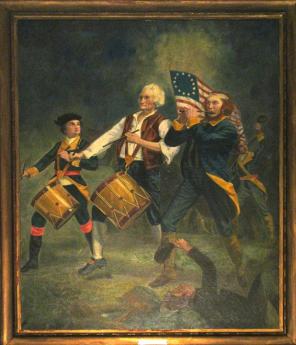
|
| Spirit of 76' |
The American colonies were growing too big, too fast, and the British Empire had too many international distractions, to have smooth relationships across three thousand miles of ocean, using uncertain communications available in the late Eighteenth century. Friction and misunderstanding were inevitable without far more statesmanship than either side thought was necessary. So, when the Continental Congress dispatched George Washington to Boston with troops to defend rebellious Massachusetts at Lexington, Concord, and Bunker Hill, it was hard for the British to believe the colonists were merely helping out one of their distressed neighbors. It seemed in London that the thirteen colonies had united, formed not only an army but a government, and gone to war. In December 1775 England passed the Prohibitory Act, essentially declaring war, and organized a huge invasion fleet to put down the rebellion. It now seems hard to understand the first notice the Americans had of this huge over-reaction was a private letter to Robert Morris from one of his agents in March 1776; no warnings, no negotiations, no attempt to investigate problems and correct them. The British just sent a fleet to settle this problem, whatever it was. It's all very well to say the Americans should have known they were playing with fire. They didn't see it that way; they were being self-reliant, responding to attack. In June 1776 British patrol frigates were skirmishing in the Delaware River; late in the month, British troops landed on Staten Island. The American reaction to all this was a muddle of confusion. A few were delighted, most of the rest were amazed or appalled.
Although the deeper strategic origins of the American Revolution are subtle, complex, and controversial, there is far less muddle about what happened on July 2, 1776, publicly proclaimed two days later. Adopting a resolution written by Richard Henry Lee of Virginia, the Thirteen Colonies stated they had now clarified their goals in the controversy with the British monarchy. For a year before that, the Continental Congress had been corresponding with each other and meeting in Carpenters Hall with the goal of achieving representation in the British parliament -- "No taxation without representation". The model for most of them was based on the Whig agitation for Ireland -- for a local parliament within a larger commonwealth. But the passing of the British Navy in Halifax, Nova Scotia, and then the actual appearance of seven hundred British warships in American waters showed that not only was Parliamentary representation out of the question, but King George III was going to play rough with upstarts. The new goal was no longer just representation, it was independence. If we were going to resist a military occupation at the risk of being hanged as traitors, we might as well do it for something substantial. The meeting had a number of Scotch-Irish Princeton graduates, whose basic loyalty to England had long been divided. Pacifist Pennsylvania, chief among the wavering hold-outs, was mostly won over by its own Benjamin Franklin, who was optimistic the French would help us. Even so, both Robert Morris and John Dickinson refused to sign the Declaration; Franklin persuaded both to abstain by absence, which created a majority of the Pennsylvania delegation in favor. That's a pretty slim majority for a crucial decision. Franklin was soon dispatched back to Paris to make an alliance; Washington was dispatched to hold off that British army in the meantime. Jefferson was designated to write a proclamation, which even after editing is still pretty unreadable beyond the first couple of sentences. Meeting adjourned. This brief account may not qualify as a serious examination of the causes of the American Revolution, but it comes close to the way it seemed to the colonist in the street.
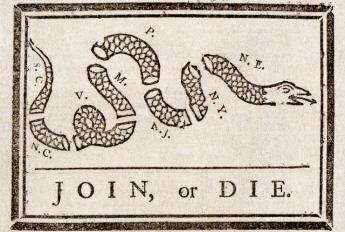
|
| Colonist's Complaint |
The rebels then spent eight years convincing the British they were serious and have been independent ever since. But, just a minute, here. Reflect on the fact that fighting had been going on for a year in Massachusetts, and that Lord Howe's fleet had set sail a month before the Declaration, actually landing on Staten Island at just about the same time as the Fourth of July. Add the fact that only John Hancock actually signed the document on July 4th, and some of the signers even waited until September. You can sort of see why John Adams never got over the idea that Thomas Jefferson had a big nerve implying the whole Revolution was his idea. What's more, there's a viewpoint that New England subsequently had to endure a President from Virginia for thirty-two of the first thirty-six years of the new nation because loud talk from New England still made the rest of the country nervous. Philadelphia may have been the cradle of Independence, but that was not because it was a colony hot for war, dragging others along with it. Rather, it was the largest city in the colonies, centrally located. It had a strong pacifist tradition, and it had the most to lose from a pillaging enemy war machine. When Independence was finally declared the goal, many of Philadelphia's leading citizens moved to Canada.
New England had started hostilities and was about to be subdued by overwhelming force. The Canadians were not going to come to their aid, because they were French, and Catholic, and enough said. What New England and the Scotch-Irish needed were WASP allies, stretching for two thousand miles to the South. By far the largest colony was Virginia, which included what is now Kentucky and West Virginia; it even had some legal claims for vastly larger territory. Virginia was incensed about its powerlessness against British mercantilism, especially the tobacco trade. The rest of the English colonies had plenty of assorted grievances against George III, and almost all of them could see that America was rapidly outgrowing dependency on the British homeland, without a sign that Parliament was ever going to surrender home rule to them. It was perhaps unfortunate New Englanders were so impulsive, but it looked as though a military confrontation with the Crown was inevitably coming. Without support, New England was likely to be torched, as Rome once subdued Carthage.
And the last hope for an alternative of flattery and diplomacy, for guile and subtlety, had stepped off the boat a year earlier. Benjamin Franklin, our fabulous man in London, arrived with the news he had finally had it "up to here" with the British ministry. He was a man who quietly made things happen, carefully selecting his arguments from amongst many he had in mind. In retrospect, we can see that he held the idea of Anglo-Saxon world domination as far back as the Albany Conference of 1745, and could even look forward to America outgrowing England in the 19th Century. His behavior at the Constitutional Convention of 1787 strongly suggests he never completely gave up that long-term dream. Just as Edmund Burke never gave up the idea of Reconciliation with the Colonies, Benjamin Franklin never quite gave up the idea of Reconciliation with England. While John Dickinson and Robert Morris resisted the idea of Independence down to the last moment, Franklin took a much longer view. For the time being, it was necessary to defeat the British, and for that, we needed the help of the French. In 1750, America joined with the British to toss out the French. And then in 1776, we joined the French to toss out the British. Franklin didn't always get his way. But Franklin was always steering the ship.
British Headquarters: Perth Amboy, New Jersey, in its 1776 Heyday (B 608)
Not many now think of the town of Perth Amboy as part of Philadelphia's history or culture, but it certainly was so in colonial times. Sadly, the town has since declined to a condition of a quiet middle-class suburb. There are quite a few Spanish-language signs around and some decaying factories. The little house of the Proprietors on the town square and the remains of the Governor's mansion overlooking the ocean are about all that remain of the early Quaker era.
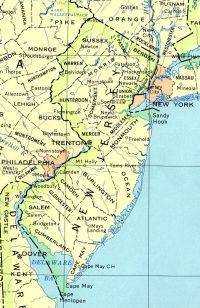
|
| NJ MAP |
To understand the strategic importance of Perth Amboy to Colonial America, remember that James, Duke of York (eventually to become King James the Second) thought of New Jersey as the land between them North (Hudson) River, and the South (Delaware) River. This region has a narrow pinched waist in the middle. It's easy to see why the land-speculating Seventeenth Century regarded the bridging strip across the New Jersey "narrows" as a likely future site of important political and commercial development. The two large and dissimilar land masses which adjoin this strip -- sandy South Jersey, and mountainous North Jersey -- was sparsely inhabited and largely ignored in colonial times. The British in 1776 developed the quite sensible plan that subduing this fertile New Jersey strip would simultaneously enable the conquest of both New York and Philadelphia at the two ends of it. It was a clever plan; it might have subjugated three colonies at once.
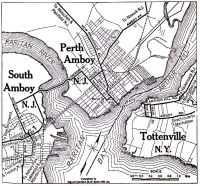
|
| PERTH AMBOY MAP |
Perth Amboy is a composite name, adding a local Indian word to a Scottish one because East Jersey had been intended for Scottish Quakers. Like Pittsburgh at the conjunction of three rivers, Perth Amboy's geographical importance was that it dominated the mouth of Raritan Bay (Raritan River, extended) as it emptied into New York Bay just inside Sandy Hook. Two of the three "rivers" of the three-way fork are really just channels around Staten Island. Viewed from the sea, Perth Amboy sits on a bluff, commanding that junction. Amboy became the original ocean port in the area, although it was soon overtaken by New Brunswick further inland when increasing commerce required safer harbors. Perth Amboy was the capital of East Jersey, and then the first capital of all New Jersey after East and West were joined in 1704 by Queen Anne. The Royal Governor's mansion stood here, as well as grand houses of Proprietors and Judges overlooking the banks of the bay. The main reason for the Nineteenth-century decline of the state capital region was the narrowness of the New Jersey waist at that point; its main geographical advantage became a curse. Canals, railroads and astounding highway growth simply crowded the Amboy promontory into an unsupportable state of isolation. The same thing can be said of Bristol, Pennsylvania, and New Castle, Delaware, but local civic pride has somehow not risen to the challenge to the same degree.
Perth Amboy Revisited
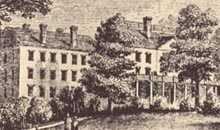
|
| Perth Amboy |
It's now moderately complicated to find Perth Amboy, New Jersey, even after you locate it on a map. Like New Castle DE it flourished early because it was on a narrow strip of strategic land, and like New Castle, eventually found itself cut off by a dozen lanes of highways crowded together by geography. It's an easy drive in both cases only if you make the correct turns at a couple of crowded intersections. Both towns were important destinations in the Eighteenth century, but by the Twentieth century, both were pushed aside by traffic rushing to bigger destinations. Industrialization hit the region around Perth Amboy somewhat harder than New Castle, destroying more landmarks, and bringing to an end its brief flurry as a metropolitan beach resort. If you aspire to preserve your Eighteenth-century glory, it's easier if you don't have too much progress in the Nineteenth. In Perth Amboy's defense, it must be noted that Jamestown and Williamsburg, Virginia had just about totally disappeared when noticed by Charles Peterson and John Rockefeller, but neither of those towns was run over by Nineteenth century industrialization. So, while New Castle has treasures to preserve and display, Perth Amboy seems to have only the Governor's mansion like the one notable building to work with. William Franklin, the illegitimate son of Benjamin, was the royal governor installed in this palace shortly before 1776.

|
| Governor's mansion in Perth Amboy |
While it is true that some wealthy local inhabitants did a lot to restore and maintain New Castle (and Williamsburg), the Governor's mansion in Perth Amboy was bought and made the home of Mathias Bruen, who is 1820 was thought to be the richest man in America. If Bruen had only had the necessary imagination and generosity, this was probably the best moment for Perth Amboy to have had a historical restoration. Instead, he added some unfortunate features to the mansion; it later became a hotel, and later on, an office building. Public-spirited local citizens are now trying to set things right, but the costs are pretty daunting. Someone has to find an inspired Wall Street billionaire like Ned Johnson to make over an entire town. Occasionally, a state government will do it, as has been done with Pennsbury. Or a national organization might become inspired, as happened with Mt. Vernon and Arlington. Its present state of peeling paint and makeshift repairs suggests uninterest in Perth Amboy's Governor Mansion by the State, and the absence of whatever it is that occasionally inspires fierce and determined local leadership. Perth Amboy needs some help and needs to forget about its handicaps. Sure, it's hard to commute anywhere, it's even hard to drive across the highways to the countryside. The bluff on the promontory was once quite arresting, now a rusting steel mill occupies that spot. Other than that, it doesn't look ominous or dangerous at all. It's just forgotten.
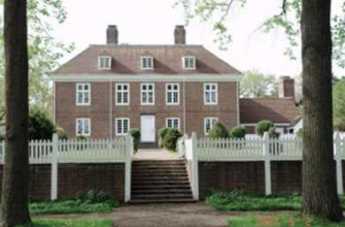
|
| Pennsbury Mansion |
Aside from the Royal Governor's former mansion, it is hard to find a historical marker or monument in this scene of former prosperity and glory, but there is one. Down on the beach is a bronze plaque, commemorating the 150th anniversary of the founding of -- Argentina. So there's a clue, which is not difficult to associate with all of the Hispanic names on the stores, and the Hispanics in evidence on all sides. They all seemed to know that this was once the capital of New Jersey, seemed pleased with it, and could point out the famous building. They are pleasant and friendly enough. Perhaps even a little too comfortable. Because, as William Franklin's famous father once said, all progress begins with discontent.
Philadelphia Vaguely Hears About Bunker Hill
The thirteen English colonies were far apart in the Eighteenth century, communicated very little, regarded their religions as more or less hostile to each other. July 4, 1776, was indeed a major turning point, but Thomas Jefferson's role was mainly to write a defensive tract to convince the colonial population and the rest of the world that the colonies had little choice but to fight. It was mainly Benjamin Franklin who recognized they could not win without foreign support, and could not expect foreign (French) support if they appeared to be willing to rejoin the British Empire. In a single action, more or less on one day, the American Revolution was transformed from New England demanding a separate parliament within a Commonwealth, into thirteen colonies fighting for Independence from Great Britain. Such a war could not be won without Virginia, the largest and richest colony, or without Pennsylvania, physically uniting the other two power centers. Virginia had serious difficulties with the British concerning its tobacco trade and its local land ambitions. Essentially, the main holdout was Pennsylvania, whose main problem now was that it was a contented prosperous state, suddenly forced to make unwelcome choices. Without Franklin's presence, it is hard to guess how things would have turned out.
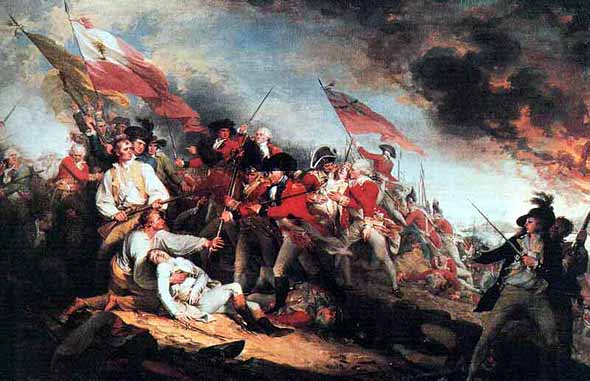
|
| Bunker Hill |
To this day, Pennsylvania has trouble appreciating that things in Boston had gone too far for New England to turn back. The quarrels about English rule had gone on for decades, and the actual warfare had escalated over three years since the Tea Party, leading to thousands of casualties. Too many people had friends and relatives killed to suppress the urge for vengeance. The British king was now revealed as deeply involved in British politics and was not at all the benign father figure he had been portrayed. The British Army thought of itself as the mightiest war machine in the world and was not going to tolerate or soon forget a bloody defeat at Bunker Hill. The Prohibition Acts had been passed, the fleet had been assembled, the honor was at stake. The Quakers of Pennsylvania may have thought they had a choice, but they had little choice.
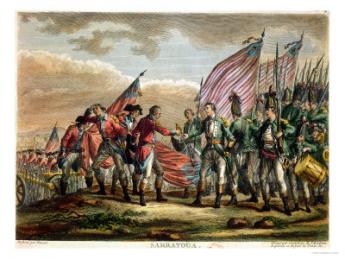
|
| Battle of Saratoga |
As a matter of fact, the British had little choice left, once the battle of Saratoga was over. With France convinced to join us (mainly by Franklin), the hope of suppressing the revolt by lack of colonist gunpowder and money was lost, and British public opinion grew progressively more opposed to warring against fellow Englishmen. Lord North seems to have realized this when he sent the Earl of Northumberland to Philadelphia to explore reconciliation, but the momentum of war forced him out of office. And the bloody revolution continued for five more years before the defeat at Yorktown forced an end to it.
The Battle of Bunker Hill probably had more effect than the questionable victory it supplied. The Americans had dragged the cannon from Ticonderoga up the mountain and they were placed on Boston's Dorchester Heights. The British saw them and rushed to get their fleet out of Boston, away from those cannon. But the Americans had no gunpowder, and Washington must have noticed you could beat the British by keeping your own nerve, even if they outnumbered you. And it wasn't the first time he saw the Brits run, he saw the same thing when he was with General Braddock.
Easy Ride: Perth Amboy to Trenton
The Revolutionary War had been raging for a year in New England before the Declaration of Independence, a point that never ceased to bother John Adams whenever Thomas Jefferson or his devotees took credit for starting the Revolution with a piece of paper nailed to a lamp post a year after Lexington and Concord. This interval nevertheless allowed for the organization of the Continental Army, and Washington's maturing military background by the summer of '76. It also allows the time for the surprisingly immediate landing of Sir William Howe's army on Staten Island at the end of June 1776. A month or so after that, his brother Admiral Howe landed more troops. By September 1776, not all of the signers had yet put their names to the Declaration of Independence, but there were about 40,000 British troops parading around the essentially uninhabited Staten Island in New York harbor, in plain sight of the inhabitants of New Jersey's capital in Perth Amboy, and scarcely a hundred miles from Philadelphia. Massachusetts and other New England Patriots have a point when they claim the Declaration of Independence marked the end of the first year of rebellion against British rule, while the other colonies prefer to say July 4, 1776, was the beginning of the war for independence. It was an irrevocable gesture of unified defiance, a copy of which was sent to the personal attention of George III.
The British shrewdly selected New York harbor as the center of their operation, since their Navy was thereby in position to shift quickly in the protected waters of Long Island Sound from New Jersey to Rhode Island, or up and down the Hudson as far as Albany, meanwhile dominating the considerable expanse of Long Island, not to mention Manhattan. It was only eighty miles travel across the narrow waist of New Jersey to the top of Delaware Bay at Trenton, potentially also leading to control of Philadelphia. Meanwhile, land-locked Washington was faced with crossing numerous rivers to defend hundreds of miles of shoreline, moving foot soldiers to defensive positions. He tried to defend New York, it is true, but the battles on Brooklyn Heights, Harlem, Fort Washington and Fort Lee were essentially unwinnable, and the best he could really do with the situation was escape with an undestroyed army. Being farther from the reach of the British Navy, Philadelphia was more defensible than New York, and besides, it was now the capital of the rebellion.
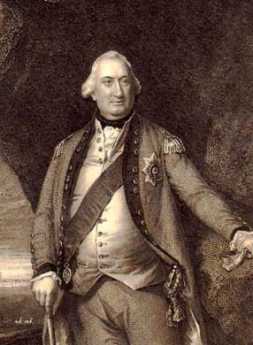
|
| Cornwallis |
By the fall of 1776 Howe had consolidated his hold on New York, and Washington was reduced to scattering small clusters of troops around the places Howe might likely invade. Those clusters were reassuring to their neighbors and easy to provision locally, but equally easy for the British to overwhelm. Washington was a better general than it seemed; these several bands of about 500 militia were expected to remain in readiness to be summoned as soon as the main British force committed itself to a major objective. In early December, the British started landing in New Jersey and marched toward New Brunswick. Washington thought that meant he was going to head for Trenton, and then down Delaware to Philadelphia. There was not much to stop him except skirmishers and Minute Men, but it was unsafe for Washington to move his troops from the New York region until the intentions of the swifter British were really clear. By that time it might be too late to stop an advance, but it couldn't be helped. Washington was inventing guerrilla warfare, patterned after his observations of the style of Indian fighting, and his observations during the French and Indian War, of the weaknesses of the British style.
Since the Raritan Strip along which Howe and Cornwallis eventually chose to advance, was prosperous and Tory, things went pretty well for the British. After two weeks march, they arrived in Trenton around December 20. In this triumph, the British failed to appreciate the significance of several things, however. Washington was hurriedly summoning six little colonial armies of five hundred to a thousand men each, to join him now that the intentions of the enemy were clear. Furthermore, the Whigs or rebels of New Jersey were aroused in the Pine Barrens of the South and the hills of the North; New Jersey was not nearly as Tory as it seemed during the initial march past the big houses along the Raritan. And, finally, the British and Hessian mercenary soldiers had indeed ravaged the countryside almost as much as the spinsters of the Whig patriot cause shouted out they had. Many neutrals were converted to rebels. The Quaker farmers were particularly upset by the activities of the camp followers, who pillaged curtains and other things not normally attractive to marauding soldiers. And the sharpshooters, both loyalist, and rebel were close enough to their own homes to dispose of another booty. It was a cakewalk down to Trenton, but it was not going to be the same coming back.
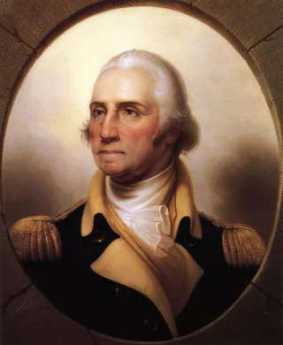
|
| Washington |
Washington was getting ready to defend the Capital in Philadelphia, and the wide Delaware river was the best place to do it. When Howe and Cornwallis reached Trenton, they found no boats available on the New Jersey side for miles up and down the river, artillery was planted in strategic places on the Pennsylvania side, ice was beginning to form on the river, it was cold, the December days were short. To them, Washington posed no particular military problem with his naked ragamuffins. Howe had some lady friends in New York, while Cornwallis was planning to spend a month in London before the spring military season. So the British generals made an overconfident miscalculation, and posted their troops in winter quarters, strung out in outposts from Perth Amboy to Trenton and down to Bordentown. A thousand Hessians were quartered in Trenton. By December 20th, it looked like a peaceful but boring Winter lay ahead.
REFERENCES
| Stories of New Jersey: Frank R. Stockton: ISBN-13: 978-0813503691 | Amazon |
Disorderly Retreat: From Trenton Back to Perth Amboy
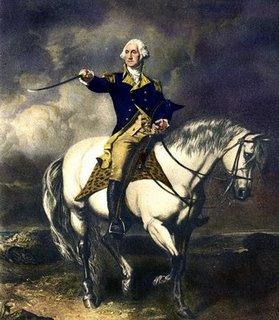
|
| George Washington on a Horse |
A week later, they got a bad jolt; Washington declined to play by their winter rules. At the Battle of Trenton, Washington was 44 years old, six feet four inches tall or more, a horseman and athlete of outstanding skill, and as the husband of the richest woman in Virginia, accustomed to housing, feeding, transporting and getting cooperation from two hundred slaves. All of those qualities may have been of some use in the battle. But after the Battle of Trenton, Washington also emerged as a remarkably bold and creative General. In the Battle of Trenton ca-----------------999999 seen the elements of audacity, timing and courage that were notable in Stonewall Jackson, George Patton -- Virginians, both -- the Normandy Invasion, and the Inchon Landing. He forged, if he did not create, the American military tradition of inspired risk-taking. And he did it with a collection of starving amateurs, up against the best Army in the world at the time. Probably without realizing it, his coming victory at Trenton also gave Benjamin Franklin in Paris a major enticement for the French King to support the American cause. Washington produced a significant achievement, but just to make sure, Franklin exaggerated it just as much as he could.
On December 21, Washington thought Howe was immediately going to sweep on through Trenton to Philadelphia. In a day or two, he saw that wasn't the plan, organized the famous re-crossing of Delaware in bad weather, and caught and captured a thousand Hessians with a three-pronged attack which cut off their retreat and made resistance useless. The main military feature of this attack was not Christmas drunkenness among the Hessians, but the fact that General Knox had somehow transported eighteen cannon to the occasion. Nowadays, the event is marked by a reenactment on Christmas Morning, although it took place on December 26, 1776. The timing did not have to do with religious observance, it had to do with hangovers. To the great disappointment of his troops, he made them abandon the great stores of booze in Trenton because a second detachment of Hessians was in nearby Bordentown, and meanwhile, he retreated back to the Pennsylvania side of the river. As might be imagined, Howe's Cornwallis promptly came charging down from New Brunswick to exact bitter vengeance. Instead of trying to rescue their comrades in Princeton, the Bordentown Hessians took off for New Brunswick. Defiantly, Washington taunted his enemies by again recrossing Delaware to the New Jersey side, put up fortifications, just waited for them to make something of it.
Well, that's the way it was meant to seem. On the night of January 2, the two armies were facing each other with about five thousand men on both sides, but with the British much better trained and equipped. The Americans had the advantage of not being exhausted by a fifty mile forced march, except for about a thousand who had been deployed forward to skirmish and delay the British advance with sniping from the bushes. The Americans made a great deal of noise and lit many bonfires behind their fortifications. But when they advanced the next morning, the British found out where the Americans really were -- by hearing distant cannon fire coming from Princeton, ten miles back toward the north.
Washington had slipped five thousand men wide around the enemy flank during the night and had taken a parallel country road to Princeton where he defeated a rear guard of British at the Battle of Princeton. An infuriated Cornwallis wheeled his army around in pursuit, and the race was on for the supplies left undefended in New Brunswick. Washington might have been able to get there first, except his men were too exhausted, and he was afraid to risk his long-run strategy, which was to avoid head-on collisions with the main British Army.
So Washington went into winter quarters in Morristown still further to the north, and thousands of British soldiers were thus bottled up in winter quarters in Perth Amboy and New Brunswick, where scurvy, lack of firewood and smallpox gave them a few months to consider their miscalculations. But the most important action of all was getting the news to Benjamin Franklin in Paris, to tell the French king of the victory. Franklin even dressed it up a little.
REFERENCES
| New Jersey in the American Revolution: Barbara J. Mitnick: ISBN-13: 978-0813540955 | Amazon |
Howe's Choice: To Philadelphia, or Saratoga?

|
| General Howe |
Nations at war traditionally vilify the leader of the enemy, and so Sir William Howe has usually been portrayed as a lazy, illegitimate uncle of the King, a womanizer lacking in military savvy, and a former parliamentary member of the minority party supporting peace with the colonies. But to go on this way is quite unfair to Washington, who outfoxed and out-generaled a tough and very clever soldier who was by no means a pushover, and who fought hard to win.
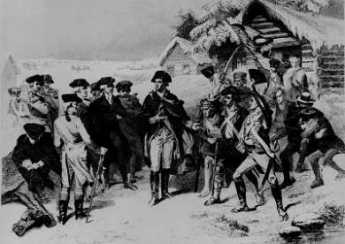
|
| Winter 1777 |
In retrospect, it can be seen that Howe's army was crammed into winter quarters on the Perth Amboy-New Brunswick bluff across the river from Staten Island in the winter of 1777, following the defeat at Trenton. Washington's troops were meanwhile in a fairly impregnable position around Morristown. If Howe went back along the Raritan toward Trenton and Philadelphia, he could expect to be butchered by snipers behind trees. If he embarked on his ships, he would be vulnerable during the two days of so required to break camp and load the ships. Washington's problem was actually just as bad. He had no way of knowing whether he had to defend against an encircling movement at Morristown, against a renewed invasion toward Trenton and Philadelphia, or against a quick movement at sea by the battleships. If Howe embarked, he might be going to Albany to rescue Burgoyne, or to Fort Lee to encircle Morristown, or to Philadelphia, or even to Charlestown. Anyone of these choices would mean that Washington would have to hurry overland to catch him.
It now seems clear that Howe had decided it was safe to abandon Burgoyne. He might have tried to capture Philadelphia and get back to Albany by September, but evidently, this seemed too ambitious and fraught with unexpected accidents, as events later proved to be true. Clear and unambiguous orders by Lord Germain in London were mislaid and never reached him. By implication, he was being told to use his best judgment. So he decided on a double option. He would send sorties out in all directions to keep Washington guessing and to entice him to come down from his mountain fastness into a pitched battle with British regulars. Failing that, he would get on his ships and take Philadelphia. Furthermore, Howe never told another soul what his plans were, except by sending a spy with misleading plans sewed into his coat, intending for him to be captured by the rebels. Washington, however, essentially refused to budge.
Finally, Howe ordered an embarkation onto his ships, and actually loaded a contingent of Hessians on board. Although Washington was mistrustful of a trick, his officers persuaded him to attack the "vulnerable" British while they were loading onto the transports. As soon as Howe heard of Washington's movement he immediately issued orders to turn the whole army around and trap Washington. He thought he now had his chance to catch and destroy the Continental army.
As things turned out, it didn't work and Washington escaped with most of his troops. Fearful of another such trap, he then held back perhaps too long and helplessly watched the ships load, weigh anchor, and sail out to sea. Where were they going? Not another person on the British (or Loyalist) side knew the answer, and the ships were far out to sea, invisible before they turned in whatever direction they were going. Was it North, or South?
A week later, word came to Washington that the fleet had been sighted off the mouth of Delaware. It was time to move South, in a big hurry, on foot. Howe was going to go to Norfolk, but it wasn't even certain whether he was coming back up the Chesapeake, or going still further South to Charleston. It remained conceivable that he would wait for Washington to move his troops South, then double back to New York and Albany to Join Burgoyne.
As we now know, Howe did turn up the Chesapeake to land in the rear of Philadelphia. And then Washington also guessed right and lined up his troops at Chadds Ford of the Brandywine Creek. Both of them were shrewd and very quick. Howe had won a major victory with superior resources. But as we shall see, Washington wasn't through with him.
REFERENCES
| The Uncertain Revolution: Washington and the Continental Army at Morristown: John T. Cunningham: ISBN-13: 978-1593220280 | Amazon |
Why Did Admiral Howe Choose the Chesapeake?
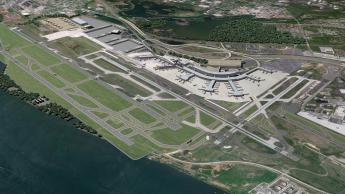
|
| Philadelphia Airport |
A passenger on a plane approaching a landing at Philadelphia Airport from the south can see long stretches of straight highway along the banks of the Pennsylvania side of the Delaware River. To drive on that highway (I-495) takes twenty or so minutes at sixty miles an hour. The thought occurs that this would have made an excellent place for Admiral Howe to land his brother's troops, well below the narrow mud flats which made Fort Mifflin so formidable, but considerably closer to his Philadelphia objective than Elkton, Maryland where he actually did land. Why would he sail all the way to Norfolk and back up the Chesapeake when a shorter Delaware trip would provide less time for Washington to prepare a defense? The long confinement of the British horses aboard ship proved to create great difficulties, which essentially undermined his plan to disembark the troops without waiting for baggage and supplies and ride into a surprised and undefended Philadelphia. And, although hurricanes were poorly understood at the time, the extra three weeks pushed the British timetable into a September landing, where they did encounter two huge storms which were probably fall hurricanes. Why did he do this when a shorter voyage seemed available?
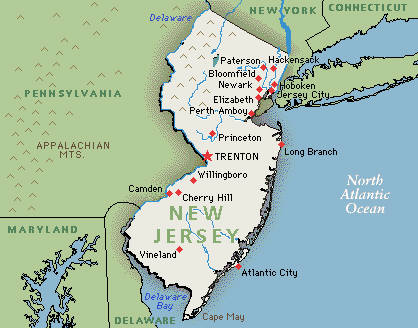
|
| Perth Amboy NJ |
Admiral Howe was notoriously secretive about his plans. He embarked at Perth Amboy without telling a single subordinate (or superior, either) what his destination was, and did not issue orders to his helmsmen until the fleet was out of sight of land. He wanted to surprise Washington, and he trusted no one. History will, therefore, have to guess what his thinking was. The question was posed to William Dorsey, a retired river pilot, a former member of the Delaware Board of Pilot Commissioners, and historian of the port. The answer was readily given: navigation of Delaware Bay was too tricky.
Whether or not they harbored rebellious sentiments against the British, or were merely protecting the livelihoods of colonial river pilots, the Board of Port Wardens was tightly protective of the charts and lore of the Bay. One Joshua Fisher had prepared what were recognized to be the most reliable charts of the snags and shallows and was willing to sell them. The Board of Wardens would have none of this, and poor Fisher was ultimately forced to move from Lewes to Philadelphia, where he had a house in what is now Fairmount Park. Furthermore, the Board was very careful to keep Tory sympathizers from becoming Delaware River pilots.
It's never safe to guess other people's motives, and at this distance, they scarcely matter. The plain fact of things is that navigation of a fleet of seven hundred sailboats up a snaggy uncharted river, without any available experienced local pilots, was just too unsafe to attempt. An extra three weeks at sea was a far safer bet.
Encampment At East Falls
The urban intersection at Queen Lane and Fox Avenue in East Falls is a busy one, and except for a few stately residences, it easily escapes notice by commuters. However, the landscape forms a bowl atop a steep hill, fairly near the Schuylkill River. George Washington had evidently picked it out as a strong military position near the Capital at Philadelphia, either to defend the city or from which to attack it, as circumstances might dictate.
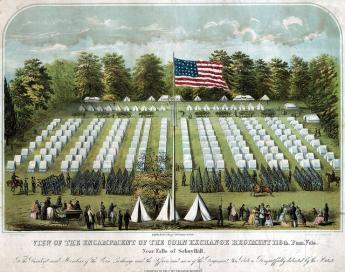
|
| Encampment at East Falls |
Washington's plans and thought processes are not precisely recorded, but when Lord Howe had sailed south from the Staten Island- New Brunswick area, he ordered his troops to head for an East Falls encampment at the southern edge of Germantown. Crossing the Delaware River at Coryell's Ferry (New Hope), the troops marched inland a few miles and then down the Old York Road to this encampment. Their stay at the beginning of August 1777 was quite brief because Washington changed his mind. When it took Howe's fleet longer than expected to appear in the Chesapeake, Washington became uneasy that Howe might be conducting a feint designed to draw the Continental troops south, and after cruising around the coast, might still return to attack down the undefended New Jersey corridor from Perth Amboy to Trenton. That proved wrong, but in Washington's defense, it must be said it was a plan that had actually been considered by the British. Anyway, Washington ordered his troops to pull out of the East Falls encampment and march back up Old York Road to Coryell's Crossing, which would be a more central place to keep his options open for the time when Howe's true intentions became clear. Washington and his headquarters staff went on ahead of the main body of troops, setting up headquarters at John Moland's House a little beyond Hatboro and a few miles west of Newtown, Buck's County. The Hatboro area was a pocket of Scotch-Irish settlement, without any local Tory sentiment, thus preferable to the rest of largely Quaker Buck's County.
To jump ahead chronologically, the East Falls encampment site must have seemed agreeable to the Continental Army, because a few weeks later it would be sought out as the main refuge and regrouping area, following the defeat at the Battle of Brandywine. The American troops were to withdraw from the Brandywine Creek when Washington realized he had been out-flanked, and head for Chester. Quickly recognizing that Chester was vulnerable, they headed for East Falls. Not only was Washington preparing to defend Philadelphia at that point, but was using the Schuylkill River as a defense barrier. As he had earlier done at the Battle of Trenton, he ordered all boats removed from the riverbanks, and artillery placed at any likely fording places, all the way up the Schuylkill to Norristown. Having accomplished that, this extraordinary guerrilla fighter then moved his troops from Germantown up the river to defend the fords. Meanwhile, Congress decided to move to the town of York on the Susquehanna, just in case.
Washington Lurks in Bucks County, Waiting for Howe to Make a Move
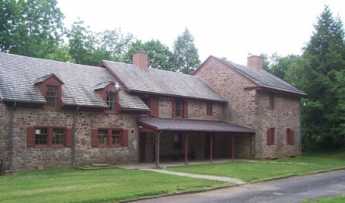
|
| Moland House |
Although Bucks County, Pennsylvania, is staunchly Republican, it has been home to Broadway playwrights for decades; this handful of Democrats have long been referred to as lions in a den of Daniels. One of them really ought to make a comic play out of the two weeks in August 1777, when John Moland's house in Warwick Township was the headquarters of the Continental Army.
John Moland died in 1762, but his personality hovered over his house for many years. He was a lawyer, trained at the Inner Temple and thus one of the few lawyers in American who had gone to law school. He is best known today as the mentor for John Dickinson, the author of the Articles of Confederation. Our playwright might note that Dickinson played a strong role in the Declaration of Independence, but then refused to sign it. Moland, for his part, stipulated in his will that his wife would be the life tenant of his house, provided -- that she never speak to his eldest son.
Enter George Washington on horseback, dithering about the plans of the Howe brothers, accompanied by seven generals of fame, and twenty-six mounted bodyguards. Mrs. Moland made him sleep on the floor with the rest.
Enter a messenger; Lord Howe's fleet had been sighted off Patuxent, Maryland. Washington declared it was a feint, and Howe would soon turn around and join Burgoyne on the Hudson River. Washington had his usual bottle of Madeira with supper.
A court-martial was held for "Light Horse Harry" Lee, for cowardice. Lee was exonerated.
Kasimir Pulaski made himself known to the General, offering a letter of introduction from Benjamin Franklin, which letters Franklin noted had been requested by Pulaski himself. As it turned out, Pulaski subsequently distinguished himself as the father of the American cavalry and was killed at the Battle of Savannah.
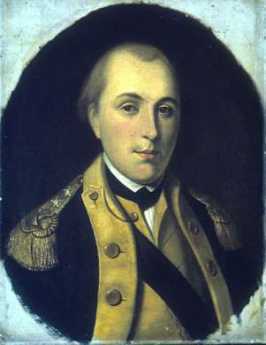
|
| Lafayette |
And then a 19 year-old French aristocrat, the Marquis de Lafayette, made an appearance. Unable to speak a word of English, he nevertheless made it clear that he expected to be made a Major General in spite of having zero battlefield experience. He presented a letter from Silas Deane, in spite of Washington having complained he was tired of Ambassadors in Paris sending a stream of unqualified fortune hunters to pester the fighting army. Deane did, however, manage to make it clear that the Marquis had two unusually strong military credentials. He was immensely rich, and he was a dancing partner, ahem, of Marie Antoinette.
In Mrs. Moland's parlor, Washington sat down with Lafayette to tap-dance around his new diplomatic problem. It was clear America needed France as an ally, and particularly needed money to buy supplies. But it was also clearly impossible to take a regiment away from some American general, a veteran of real fighting, and give that regiment to a Frenchman who could not speak English and who admitted he had no military experience. Fumbling around, Washington offered him the title of Major General, but without any soldiers under his command, at least until later when his English improved. To sweeten it a little, Washington seems to have said something to the effect that Lafayette should think of Washington as talking to him as if he were his father. There, that should do it.
It seems just barely possible that Lafayette misunderstood the words. At any rate, he promptly wrote everybody he knew -- and he knew lots of important people -- that he was the adopted son of George Washington.
Well, Broadway, you take it from there. At about that moment, another messenger arrived, announcing Lord Howe at this moment was unloading troops at Elkton, Maryland. General Howe might have been able to present his credentials to Moland House in person, except that his horses were nearly crippled from spending three weeks in the hold of a ship and needed time to recover. Heavy rains were coming.
(Exunt Omnes).
Suggested Stage Manager: Warren Williams
Defeat and Disaster: Philadelphia Falls to the Enemy
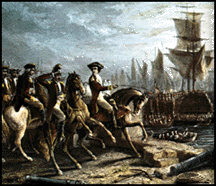
|
| Howe |
Helen of Troy had launched a thousand ships. Lord Howe only launched four hundred and thirty, but they were bigger. It is estimated a thousand oak trees were cut down to build just one man o' war. To repeat what happened next, this flotilla was parked in lower New York harbor while forty thousand redcoats conquered Brooklyn Heights, Manhattan, Washington Heights, Perth Amboy, New Brunswick, Princeton, Trenton -- and then Washington promptly made fools of Howe and Cornwallis, at Trenton, Princeton, New Brunswick. Howe, and Cornwallis, in particular, were raging mad. The first year of the two-year siege of Philadelphia was over, and at half-time, the British team was popped up.

|
| Lord George Germaine |
The grand plan laid out in London by Lord Germaine was for Howe to capture New York, and maybe Philadelphia if it would be useful, while Gentleman Johnny Burgoyne took an army from Canada along that giant cleft in the earth which starts at the St. Lawrence River, down Lake Champlain, then down the Hudson from Albany to New York. The Hudson is very wide, and the British Navy would have no trouble sailing upriver to Albany, landing an army to meet Burgoyne coming south, with the effect of cutting New England off from the rest of the Colonies. Burgoyne got his orders in London shortly after Howe's January disaster in Trenton arrived in Quebec in May and started on his campaign June 20. Nothing dilatory about him. Howe, however, had six months to get to Albany before that, and several months more before Burgoyne would get to Saratoga, tromping through the woods and black flies. From Staten Island, it might have taken Howe ten days to sail to Albany in plenty of time.
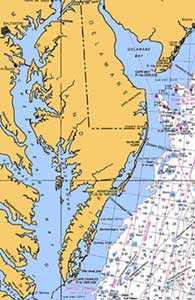
|
| Chesapeake Bay |
Instead of that, Howe solitary and without advice, decided to take Philadelphia. Although the British never dwelt much on the fine points, the actual rebellion was only taking place in New England at the time the fleet set sail. It was the arrival of the fleet which triggered the Declaration of Independence, not the other way around. Lord Howe therefore probably felt some justification in revising the agreed plans and orders under which he set sail. As has been described already, the initial foray to Trenton ended embarrassingly. So, the capture of the enemy capital would now help people forget Princeton, and it would be sweet to whip Washington.
Unfortunately, they wasted a lot of time doing it. Finding Delaware too well fortified, and almost as snaggy as Henry Hudson had found it more than a century earlier, he sailed all the way to Norfolk, came up the Chesapeake and landed at the head of Elk, and marched for Philadelphia. The Brandywine Valley has deep sharp cliffs off to the right, so Cornwallis was sent off to the left as a flanker past Dilworthtown while Howe attacked Washington head on at Chadd's Ford. It was to be the largest battle of the whole Revolutionary War. When Washington found himself facing encirclement, he had to order a withdrawal. To skip a few events now memorable to the Main Line suburbs, Philadelphia was essentially then occupied without a further fight, with the British set up their defenses at Germantown, seven miles from the center of town. Three weeks later, Washington attacked Germantown in a three-pronged assault that mainly failed because two of his formations attacked each other in the fog. That was October 4, 1777. The news soon reached them that Burgoyne had surrendered the other British army --starving in the woods -- at Saratoga, New York on October 17. Howe had in effect abandoned Burgoyne in order to take Philadelphia, but it was probably as much a result of getting drawn into a tangle, as a single decision to disregard the grand plan.
In retrospect, it was quite a bad choice. All the world -- and the King of France in particular -- could see that Washington had beaten Howe at Trenton and then Gates and Benedict Arnold had soon beaten Burgoyne at Saratoga. General Gates, of course, was in charge at Saratoga, but Arnold was the flamboyant hero. Adding to his earlier exploits in Quebec and later providing the captured cannon of Ticonderoga for General Knox to drag over the mountains to Boston, thereby allowing Washington to drive the British fleet to safer distances, Arnold now essentially won two more battles at Saratoga. The first was to defeat Leger, who had been sent down Lake Ontario to come back up the Mohawk Valley to Albany. Then, turning his troops through the woods, Arnold joined Gates at Saratoga and defiantly led the charge that smashed the British line, when Gates would have been satisfied with containment. Arnold, like Alexander Hamilton, was a flamboyant man after Washington's heart.
Meanwhile, Howe settled down to enjoy winter at Philadelphia. His court jester and chief entertainer were Major Andre, who took wicked pleasure in using Ben Franklin's Market Street home as his own. There was additional satisfaction in knowing that Washington was freezing at Valley Forge.
Battle of the Clouds: September, Remember
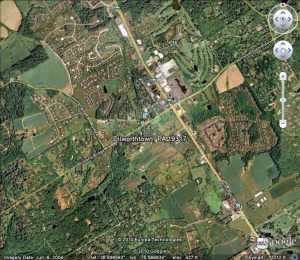
|
| Dilworthtown |
Weather satellites, television and so on have taught us much about hurricanes that was unknown in 1777. Benjamin Franklin, it should be noted, was the first to observe that Atlantic Coast "Nor'easters" actually begin in the South and work North, even though the wind seems to be blowing in the opposite way; what's moving toward the northeast is a low-pressure zone. We now know that hurricanes begin in Africa, travel West and then veer North when they reach Florida. A great deal is still to be learned about hurricanes, but the most important thing about their timing is contained in a maritime jingle:
June, too soon.
July, stand by.
And then: September, remember.
October, all over.
Along the Atlantic east coast, the end of August to the middle of September, is hurricane season. That's when houses blow down in Florida, and heavy rains hit Pennsylvania. Admiral Howe might have had some clue to this, since Franklin made his observation around 1750, and storms are important to Admirals. But very likely his brother the General just thought it was one of those things when the British landing at Elkton, Maryland in late August 1777 was greeted with an unusually severe downpour of rain. Howe had planned to surprise Philadelphia from the rear by hitting the ground running on horseback. However, he underestimated the debilitating effect on the horses of three weeks at sea on sailboats; to unload and forage horses during a hurricane was almost too much for the plan. For that purpose, he had given orders for the troops to disembark without waiting to pitch camp, or unpacking their gear. But the drenching rain gave Washington several extra days to organize a defense, although he has been given too little credit for the strenuous accomplishment of moving an army from Bucks County to the banks of the Brandywine in that weather. Howe, whose trademark was surprise, deception, outflanking, had anticipated a sudden cavalry thrust into the backyards of unprepared Philadelphia. What he got was 2000 casualties in the biggest battle of the Revolutionary War, against Washington's well-prepared defense along the steep-sided Brandywine Creek.
Howe won this battle, in the sense that Washington was forced to withdraw, because Howe employed another British military trademark, of driving his own troops beyond humane limits in a huge outflanking movement. The countryside around Kennett Square is hilly and broken almost to West Chester, and the American Army felt reasonably prepared along a front of ten or twelve miles. But Howe drove the main force of his army seventeen miles to the north, to Dillworthtown, before turning the unprepared American right flank. And, in the now hot August weather in full uniform and battle pack, the drive continued for twenty-four consecutive hours until Washington saw he had to withdraw. This was what the British meant when they boasted of seasoned regular troops; you win by enduring more than your opponent can endure.
One has to have equal admiration for Washington. Although he was dislodged from his position, losing the opportunity to catch the British in a hostile region without a reliable source of supplies once the fleet weighed anchor, he preserved his army of marksmen and deer hunters intact during the retreat. The two armies started at roughly the same size, and Washington had only about 1300 casualties; his men had more certain supply sources, and they were fighting for their homes. The British, somewhat outnumbered, had the prospect of fighting their way without resupply through an enemy's home territory, capturing the enemy's capital, but still facing the possibility that the British fleet might not get past the Delaware River defenses. If that happened, they could celebrate their victory by starving to death. Just about the only weakness of the Continental Army was its discomfort with bayonet warfare. They could hit a squirrel at a hundred yards, but those long bayonets on the end of very long muskets were designed to protect foot soldiers from cavalry charges. It takes training to put the butt of the musket against a stone on the ground, hold your ground against an oncoming gallop of horsemen, and trust that at the last moment the horses will rear back and throw the riders. But it also takes naked bravado to wave a sword and ride full tilt into a forest of pointing bayonets, trusting that at the last moment the defenders will break and run.
But Washington knew what he was doing. He pulled the troops back to Chester, then over the Schuylkill to the Germantown encampment at Fox and Queen Lane, then up the Schuylkill to Norristown, the first ford in the river that Howe must use when the boats and bridges were destroyed. The river would hold the British while the Americans came at them from the rear; this was essentially the same river strategy he used at the battle of Trenton. Washington picked his battlefield in Chester County and got ready to fight the second installment of the Battle of Brandywine. The campus of Immaculata University now occupies the site.
And then it rained, again. Hard. The gunpowder on both sides was soaked, useless. In what has come to be known as the "Battle of the Clouds", the fighting was called off by mutual agreement. The second hurricane of the year had arrived, and Washington more or less helplessly had to watch Howe take over Philadelphia unopposed. He lost the capital, provoking dismay among the colonists, but his masterful strategy taught the British to respect him. When the British were later considering whether to hold or abandon Philadelphia, this growing respect for their adversary helped tilt their thinking toward prudence.
But that was not before Howe once more showed he too was not the lazy slacker that others had called him. General "Mad Anthony" Wayne was dispatched with fifteen hundred troops to hassle the rear of Howe's army. Wayne was confident he could hide his troops in the Radnor area where he had been brought up, but the region in fact had many Torys to report his movements. Howe ordered Major General Lord Charles Grey to take the flints from his troops' muskets, attack the American camp near Paoli's tavern in the night, and use only bayonets. Waynes' troops were scattered and slaughtered, in what came to be known as the Paoli massacre.
Fort Washington, PA
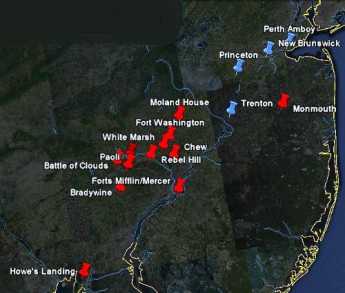
|
| British Campaigns |
The Revolutionary War lasted eight years, so there are a half dozen Fort Washingtons, in several states. Pennsylvania's Fort Washington gets free advertising from being a stop on the Pennsylvania Turnpike at the intersection of the East-West branch and the North-South branch, near some very large shopping malls. Nevertheless, the suburbs haven't reached it yet, and it is on a series of wooded mountain ridges discouraging housing development. Another way of describing its location is that it is several miles north of Chestnut Hill along the Bethlehem Pike, a road which begins in the center of Chestnut Hill at Germantown Avenue. The Pike is quite old, with many surviving colonial-era houses and inns to liven up the trip.
A third way to describe Fort Washington is that the headquarters were at the point where Bethlehem Pike crosses the Wissahickon Creek. How's that again? How does the western Wissahickon Creek then flow uphill to Chestnut Hill? Of course, it doesn't, but the appearance takes some explaining. The northwestern end of Philadelphia is reached by two ancient roads running on ridges quite close together like the split tail of a fish. Germantown Avenue runs up one ridge, and Ridge Avenue runs up the second ridge closer to the Schuylkill. The Wissahickon runs in the gully between these two ridges and tumbles down the hill at Wissahickon Avenue, or Rittenhousetown if that is more understandable. The ridge of Ridge Avenue is essentially cut off by the creek, but engineers have put Ridge Avenue on a high arching bridge as it crosses the creek far below, and by this magic Ridge Avenue and Germantown Avenue are at about the same height most of the way. The Wissahickon Creek is really running downhill the whole way, but sort of disappears from sight and reappears as it twists through the gorges, misleading the casual visitor (or commuter). As happened so often during the Revolutionary War, Washington showed his understanding here of geography in the service of guerrilla warfare.
Since the British were headquartered in Germantown, and the Americans have camped a few miles away on the same creek, it was inevitable there would be some sort of battle in the region. Washington launched a three-pronged attack on the British soon after arriving at Fort Washington, but his troops fired at each other in the fog, and apparently, two prongs more or less got lost in the gorges. The Americans retreated, and the British consolidated their conquest of Philadelphia. They did launch one surprise attack on the American encampment (the Battle of Whitemarsh), but that was mainly a reconnoiter, given up after a few days when it became clear Washington's troops held the high ground. It really is high ground (hawk-watching platforms and all) for reasons already stated. Chestnut Hill is a pinnacle sticking up on the west side of the Creek, with the Wissahickon snaking around its base.
This really was a perfect place for Washington to aim for after the Brandywine Battle, close enough to threaten the British, located in a bowl-like valley for camping, but terminating at the top of a mountain ridge in case the British counter-attacked. And with plenty of running water from the Wissahickon. However, it was a little too close for comfort, and he withdrew across the Schuylkill into Valley Forge as a more substantial natural fortress. Valley Forge is also on a hilltop, but one sitting in the middle of the Great Valley (Route 202 to Wilmington), as the center of an angel food cake tin. No doubt, the advantages of this new location became evident to him at the earlier skirmishes of the Battle of the Clouds, and the Paoli Massacre, which occurred nearby.
In retrospect, these maneuvers and skirmishes were of little military significance, except for the major Battle of Brandywine. The lost opportunity was the chance to catch the British Army without supplies or access to the Navy, aborted by what was probably a hurricane, the so-called Battle of the Clouds. Philadelphia was lost, and the opportunity to win the war early by smashing a third British army was gone for good. The defeat of the Hessians at Trenton, the loss of Burgoyne's army at Saratoga, and a victory on the outskirts of Philadelphia might together just have finished the War. But things didn't work out, the British similarly missed some opportunities, and the war was to last another five years. Once the French allied themselves, their wealth and naval strength tended to make French priorities dominate strategy.
Nevertheless, a perfectly splendid tourist trip awaits the history buff who travels from Elkton, Maryland, where the British landed, to the Battle of Brandywine battlefield, up the Great Valley to Immaculata University where the Battle of the Clouds took place, over to the Battlefield of the Paoli Massacre, crossing the Schuylkill and going to Whitemarsh, then to Fort Washington, and back up Bethlehem Pike to Germantown Avenue, and down to the Chew Mansion. The campaign for the conquest of Philadelphia ended with the fall of Ft. Mifflin when the British fleet was finally able to re-supply Howe's army. This direct auto tour is a little out of chronological sequence, but it can be done in one day if you don't dawdle. If you slow down and spend an extra day, you can include the Moland House where Washington waited to see where General Howe was going. At the right season, there's hawk watching on the ridge at Fort Washington Park, and maybe on to Trenton, or even up the New Jersey waist to Perth Amboy on lower New York Bay, where the Howe brothers began and ended their Philadelphia adventure. That would take you past Princeton and New Brunswick, or even include a trip to the Monmouth Battleground. With this extension, you have traveled much of the extent of the Revolutionary War in the Mid-Atlantic states.
The Battle of Germantown: Oct. 3, 1777
After its brief commotion from the unwelcome French and Indian War, Germantown settled down to a 22-year period of colonial inter-war prosperity and quite vigorous growth. Most of the surviving hundred historical houses of the area date from this period, and it might even be contended that the starting of the Union School had been a beneficial stimulus.
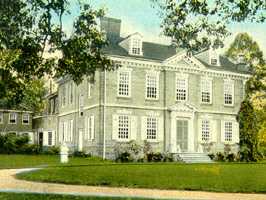
|
| Cliveden |
Two decades passed. What we now call the American Revolution started rumbling in far-off Lexington and Concord, soon moved to New York and New Jersey. General William Howe, the illegitimate uncle of King George III, then decided to occupy the largest city in the colonies, tried to get his brother's Navy up Delaware but hesitated to persist in a naval attack on the chain barrier blocking the river. He considered but abandoned trying to outflank the New Jersey fort at Red Bank, the land-based artillery at Fort Muffling, and heaven knows what else along the twisting shaggy Delaware river. Giving up on that approach, Howe sent the navy down to Norfolk and back up the Chesapeake, landing the troops at the head of the Elk River. Washington was outflanked at the Battle of the Brandywine Creek trying to head him off, although he suffered far fewer casualties than the British. A rainstorm, presumably a fall hurricane, disrupted his planned counterattack near Paoli. So Howe invested Philadelphia, organizing his main defensive position in the center of Germantown. His headquarters were in Stenton and Morris House, General James Agnew was at Grumblethorpe The Center of British defense was at set up at Market Square where Germantown Avenue crosses Schoolhouse Lane. With Washington retreating to Valley Forge, that should take care of that. Raggedy rebels were unlikely to attack a prepared hilltop position with a river on either side, defended by a large number of British regulars.
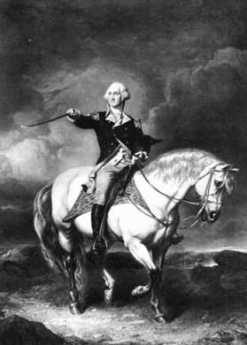
|
| George Washington |
Washington did not look at things that way, at all. Cut off from their fleet, the British situation would be precarious until Delaware could be re-opened. He had watched General Braddock conduct with bravado an arrogant suicide mission in the woods near Ft. Duquesne, and also knew the British always based as much strategy as possible on their navy. Washington's plan was to attack frontally down the Skippack Pike with the troops under his direct command, while Armstrong would come down Ridge Avenue and up from the side. General Greene would attack along Limekiln Road, while General Smallwood and Foreman would come down Old York Road. In the foggy morning of October 3, the main body of American troops reached Benjamin Chew's massive stone house, now occupied by determined British troops, and General Knox decided this was too strong a pocket to leave behind in his rear. Precious time was lost with an artillery bombardment, and unfortunately, the flanking troops down the lateral roads were late or did not arrive at all. The forward movement stopped, then the British counter-attacked. Washington was therefore forced to retreat, but he did so in good order. The battle was over, the British had won again.
But maybe not. Washington hadn't routed the British Army or forced them to leave Philadelphia. They did leave the following year, however, and there was meanwhile no great desertion from the Colonial cause. Washington's troops suffered terrible privation and discouragement at Valley Forge, but the crowned heads of Europe didn't know that. For reasons of their own, the French and German monarchs were pondering whether the American rebellion was worth supporting, or whether it would soon collapse in a round of public hangings. From their perspective, the Americans didn't have to win, in fact, it might be useful if they didn't. But if they were spirited and determined, led by a man who was courageous and resolute, their damage to the British interests might be worth what it would cost to support them. The Battle of Germantown can thus be reasonably argued to have been an advancement of colonial goals, even if it could not be called a victory. However, when the news of Burgoyne's defeat at Saratoga soon reached them, the European enemies of England decided the colonists would be useful allies.
In Germantown itself, the process of turning a military defeat into a strategic victory soon began, with severe alienation of the German inhabitants against the destructive experiences of British military occupation. After a winter of near starvation, Germantown would never again see itself as the capital city of a large German hinterland. It was on its way to becoming part of the city of Philadelphia.
Espionage in the Revolution

|
| John Nagy |
Both sides fighting the Revolutionary War predominantly spoke English as a native language, so it seemed deceptively simple to pick up a little cash for a tidbit of information or two. John Nagy, who has written several books on spies in the Revolution, recently addressed the Right Angle Club about this interesting topic. According to him, Quakers were favorites as spies because they were widely split in their sympathies, and as pacifists were abundant in the civilian societies of the time. Others have commented that the main difference between Conservatives and Free Quakers was that the Free Quakers were mostly of the artisan class and sympathetic to the Revolution, while the Conservatives were mainly of the merchant class, and Tories. But there were many exceptions, and the plain dress Quakers were hard to tell apart and passed freely through the military lines. No doubt many readers will be incensed by such comments, for which we take absolutely no responsibility.
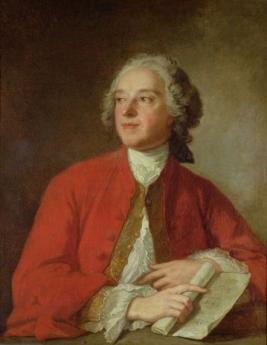
|
| Beaumarchais |
The one main exception to the English-language generalization were the French, who were still smarting from their defeat in the Seven-Years (French and Indian) War. The playwright Beaumarchais was quite active in the French movement to make trouble for the hated English and seems to have stirred up King Louis XVI to be interested in financing rebel trouble-makers, if not to become active combatants. In any event, a wary King thought it was best to send a spy to look over the situation. As detailed in a little pamphlet called The Spy in Carpenter's Hall the Americans were tipped off about the plot. Accordingly, the spy named Bonvoloir was hidden up on the second floor of Carpenter's Hall, while the colonists put on a belligerent falsified performance on the first floor. It is claimed their performance was a convincing one, having the desired effect of creating a report to the King that the colonists were belligerent, warlike, numerous and united. After the Battles of Trenton and Saratoga, the timing was good for using this sort of report to provoke the King into doing what he was mostly of a mind to do, anyway.
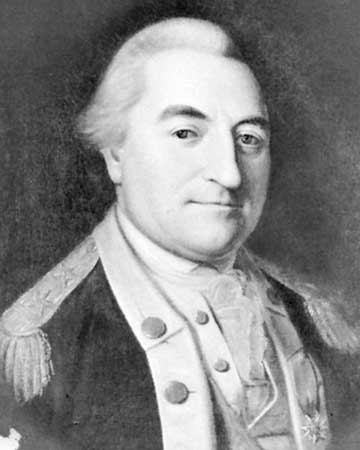
|
| Johann de Kalb |
The French were unusual in favoring aristocrats as spies and Johann de Kalb was anther who snooped around, returning later in the form of General de Kalb of military note. The names of British spies, aside from Major Andre, tended to have a Quaker sound to them, like Dunwoody, Cadwalader Jones and the like. It would take deep research to know whether these were Quaker stalwarts or merely black sheep of some family; there is little doubt that sympathies changed with the changing fortunes of battle. Another feature was the careless lying which took place for propaganda purposes. The famous story of Lydia Darragh, a Quaker who allegedly overheard the British officers plotting the surprise attack on Whitemarsh on December 5, 1777, and walked many miles in the snow to warn Washington -- is apparently a much dressed-up version of what happened. The whole Darragh family was engaged in regular spying, and the evidence is that Lydia's brother William was the one who was the messenger. He apparently carried messages under the cloth covering of the buttons on his coat.
.jpg)
|
| Joseph Galloway |
Two types of spying have a greater ring of authenticity. The British needed pilots to guide their ships up the Delaware past fortifications and obstacles. Maps were nice, but it seemed simpler to enlist the efforts of two ladies of easy virtue, Ms. O'Brien and Ms. McCoy, to hang out in taverns and entice local ship pilots to enlist to guide the British ships into Philadelphia. The British spymasters even had the ingenuity to entice a member of the Continental Congress, Joseph Galloway, to turn over the commentary records from which troop strength could be estimated from the food consumed. It is not recorded whether suitable adjustments were made for starving troops, stolen supplies, or fraudulent charges, however.
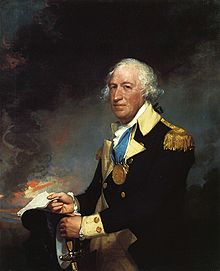
|
| Benedict Arnold |
Two prominent officials were accused of selling out the side, but an accusation of this sort is easily made, hard to prove. When the examples of Benedict Arnold and Peggy Chew can be verified, however, there is always doubt cast on everyone which some will believe. The system of double signatures was used, so there were two co-treasurers of the United States, Joseph Hellegas and George Clymer. Letters have been produced indicating that one or the other sold the commissary records. Hellegas' home is still today the residence outside Pottstown of a prominent Philadelphia surgeon, and his portrait appears on the ten-dollar bill. In so doing, he started a tradition of Secretaries of the Treasury on the ten-dollar bill, presently occupied by Alexander Hamilton. George Clymer, for his part, was a signer of the Constitution and a favorite of George Washington. Are these stories true? Who knows, but in an eight-year war, John Nagy has accumulated evidence that there were over five hundred documented spies. The essential question remains one of whether to believe the documents.
Peggy Shippen and Benedict Arnold: Fallen Idols
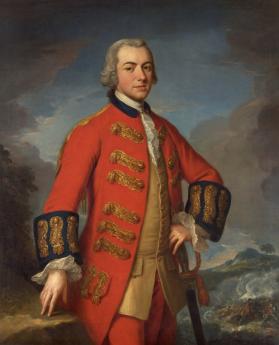
|
| General Burgoyne |
After defeating Washington's troops at the battle of Germantown, the British then occupied Philadelphia for the better part of a year. The town was a mess, with food shortages typical of the squalor of any occupying army equalling the existing population. Washington was forced to fall back to the natural fortress of Valley Forge. The city of Philadelphia was not exactly under siege, but it was as difficult a place for British troops to live as a besieged city. For his part, Washington was forced to shiver and starve in the nearby mountain valley, at least consoled by distant news of American achievements. General Burgoyne and his army were soon captured at Saratoga by General Gates under humiliating circumstances. Clearly, the dashing hero of this event had been Benedict Arnold on a white horse leading the charge, getting wounded in the leg in the process.
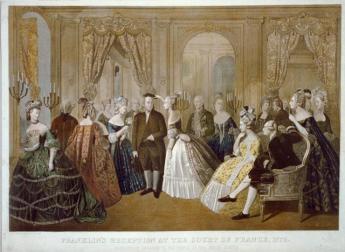
|
| Benjamin Franklin in Paris |
Benjamin Franklin in Paris trumpeted the news of this victory, reminding the French of Washington's earlier victory at Trenton, and maneuvering it all into a treaty of alliance. With the French fleet in the nearby Caribbean, Philadelphia was no longer a safe place for the British to stay a hundred miles upriver, and the idea of abandoning occupied Philadelphia began to grow. Having gambled on British victory in defiance of London's orders, the Howe brothers were not in a position to argue with new orders. The British soldiers inside the city were more comfortably housed than the American troops outside it, but nobody was exactly comfortable. The American Congress had, of course, fled to the hinterlands. All in all, it suddenly became uncertain who was going to win this war.
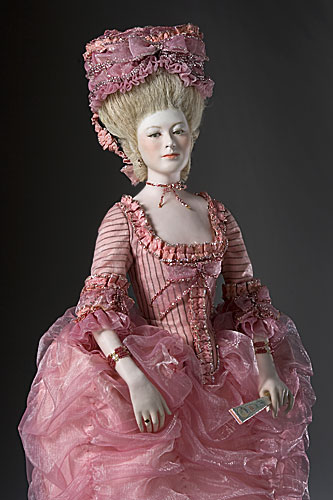
|
| Peggy Shippen |
The American population at this time has been described as a one-third rebel, one-third Tory, and one-third trying to hunker down to see who would win. Many of the seriously committed Tories had fled from Philadelphia when the rebels took charge, while pacifist Quakers were a little hard to classify. Generally speaking, the prosperous merchant class had never been persuaded King George was all that bad, while the less prosperous artisans were the fervent patriots. Under such conditions, many people who privately leaned in either direction found it was best to seem non-committal. The British were billeted in private homes; the Officers in the best houses of the merchant class, the common soldiers generally housed in the homes of the artisans. Although the soldiers and the artisans did not mix very well, circumstances permitted the aristocratic officers getting on pretty well with the merchants whose houses they occupied. The girls in the colonial families seemed immediately attractive to the British officers, who were far from home, while the officers also seemed pretty glamorous to the girls. So, it is not exactly surprising that the most beautiful colonial belles like Peggy Shippen and Peggy Chew found themselves frequently in company with dashing officers like Major John Andre. Andre would likely have been a heartthrob in any circumstance since he had risen to the rank of adjutant-general at a young age, wrote poetry and plays, reputedly was rich, and was regularly the life of any party. Nor is it surprising that generations of Peggy's descendants have treasured a lock of his hair.
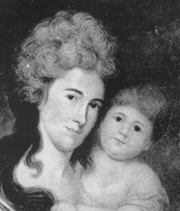
|
| Margaret Oswald Chew Howard |
When the decision was finally made to abandon Philadelphia, six of the British officers personally contributed twenty-five thousand dollars to throwing Philadelphia's most famous, most splendiferous party, called The Machianza. It went on for days, had real jousting matches between officers dressed like knights in armor, banquets and all that sort of thing. It was Andre's idea, and he was enthusiastically in charge. Surviving records of the event do not show that Peggy Shippen was present, but in view of what happened later, much of her correspondence has been destroyed. It's pretty hard to imagine she wasn't there.
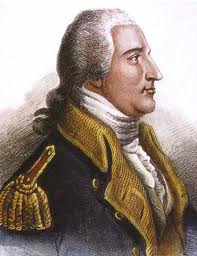
|
| Major General Benedict Arnold |
The British then marched away, and Washington's troops cautiously followed, assuming control of the city. Major General Benedict Arnold had been sent from Saratoga to Valley Forge to recover from his leg wound, and probably also to raise morale among the troops celebrating the now-famous hero. Washington more or less immediately decided to pursue the British across New Jersey, thus leading to the battle of Monmouth as the two armies raced for the Naval vessels in lower New York harbor. Since General Arnold had not fully recovered from his wounds, he was installed as the military governor of a somewhat bedraggled Philadelphia. Naturally, he was the center of the social scene, and soon was pursuing Peggy Shippen in every way he knew, which included some pretty gloppy letters in Romantic style. Peggy's father was uneasy about his intentions but was eventually mollified by Arnold's purchase of the house called Mount Pleasant, now a tourist attraction in Fairmount Park. With this evidence that his prospective son in law was at least likely to stay in Philadelphia, Edward Shippen finally repented of his opposition to the marriage of his daughter. But the new couple were soon off to West Point, where Arnold had kept up a persuasion campaign with George Washington, to get himself appointed the commandant of the main northern defense of the Hudson River. A point for Philadelphian tour guides to remember is that Peggy and Benedict never got a chance to live in Mount Pleasant.
Arnold originally lived in New Haven, Connecticut, where he had established quite a sea-faring reputation as a merchant, some would say privateer, others would say buccaneer. There is no doubt he was aggressive, and combative, and considered himself a little bit above the law. These qualities made him outstanding at Fort Ticonderoga and Saratoga, and are always more highly valued in young men in a war. Unfortunately, he made a bitter enemy of Joseph Read who was briefly his neighbor, and later was President of the Continental Congress. Read accused Arnold of smuggling and trading with the enemy, and was so determined about it that Arnold was scheduled for court-martial, but postponed. Arnold was loudly defensive about the whole matter, and public sympathy was on his side. In view of what soon happened, he might well have been cleared by the court, but likely there was some truth to the accusations. Using Peggy as a go-between, he entered into a correspondence with Andre (then the adjutant-general in New York) offering to deliver the surrender of West Point, three thousand prisoners, and possibly George Washington himself in return for what might today be half a million dollars. As a note of realism, he was willing to accept half that in the event of failure. The British were particularly anxious to acquire American prisoners to exchange for their own troops captured at Saratoga. Unless Arnold was a total sociopath, he must have thought he had quite a grievance.
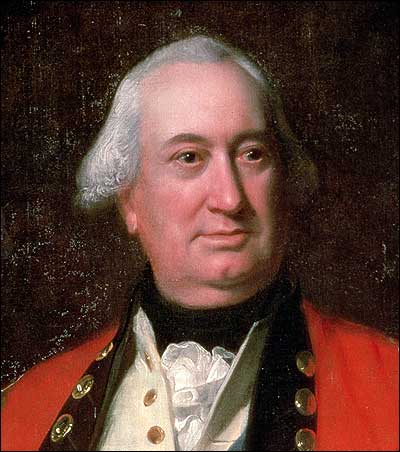
|
| Lord Cornwallis |
Things went along surprisingly well at first, with negotiations for price back and forth, plans for attacking West Point moving along with the Navy, and Andre disguising himself for a visit to Arnold in his house to the south of the Fort on West Point. Much of the success was due to the movie-star reputation of Benedict Arnold; few could imagine such a hero doing such an unheard-of thing. However, the plot was discovered while Washington was away visiting the Fort, and Arnold hastily abandoned his family and fled to a waiting British warship. Andre decided to make his way south to the ship through rebel territory, but local soldiers and farmers were much more suspicious than others had been, and after penetrating his disguise, found incriminating papers concealed in his boots. Since he was out of uniform behind enemy lines, Andre was by definition a spy, which required hanging. He made a plea to be shot like a gentleman, but Washington with tears allegedly in his eyes refused. With much bravado, Andre jumped atop his own casket and placed the noose around his own neck, a behavior much admired by his compatriots when they heard of it
Meanwhile, Peggy had put on a crazy-woman act which apparently convinced Washington to be lenient, and allow her to rejoin her husband. The couple stayed in New York for a few months, toying with commands of loyalist troops in the south, but eventually taking ship for England. Lord Cornwallis was on the same ship and they became pals as shipmates, pleasing Arnold quite a lot. Unfortunately, British society was only stiffly polite to them, and many did not trouble to conceal their disdain for traitors to any cause, and thus life in England was not smooth. By that time, it is possible that many had begun to suspect the whole idea of treason was Peggy's idea from the start, as is today the conventional view of it. As an American aristocrat, she was uncomfortable with the rebels in Philadelphia, and as the impetuous wife of an accused smuggler, it was difficult to fit in with either the Quakers or the merchants with loyalist leanings. No doubt she heard some catty whisperings among her friends and relatives about her other romantic associations. The British paid them their promised pensions, but a career in the British Army was out of the question for her husband. But the real shock would come, from discovering the British as a whole didn't much care for their behavior, either.
Rebel Hill
The Schuylkill River, hence Schuylkill Expressway and also Amtrak, all take a big bend westward about ten miles from Philadelphia. They are making a detour around a big hill or minor mountain, tending to position the sun in the eyes of many commuters at certain hours of the day. Real estate developers are apparently responsible for naming the place Rebel Hill, and it's getting pretty crowded with houses. The Rebel they had in mind was George Washington.
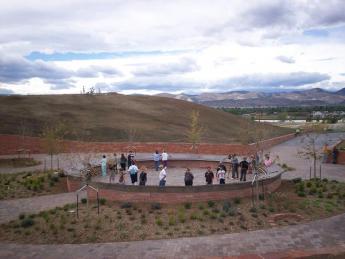
|
| Rebel Hill |
The father of our country was in retreat from the battle of Germantown, having crossed the river at Matson's Ford, then following Matsonford Road over and beyond the big hill, and pausing for water at the spring in the gulch formed by Gulch Creek, now more decorously called Gulph Creek. The creek tumbles down the side of a long ridge forming the south side of the Great Valley; the gulch or gulf is really a crevasse in that ridge, which in a sense makes Rebel Hill just a split-off extension of that ridge. Consequently, the gulch makes a water-level route from the Schuylkill to Valley Forge, which anyone would take to get there in a hurry. Valley Forge is a misleading term; it's a hill in the middle of the Great Valley, as the center of an angel food cake tin, and was thus defensible in all directions. The cleft in the southern ridge is where you would normally travel to get to the base of the bastion of Valley Forge.
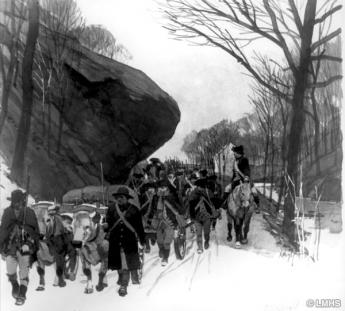
|
| Old Gulph Road |
So, everyone still takes that route, following Montgomery Avenue after it turns into South Gulph Road, but before it turns into North Gulph Road. The road up along the southern ridge is called Old Gulph Road, while the newer extension from the river is called New Gulph Road. All of these winding roads are compressed within the narrow defile beside Gulph Creek, reachable by splashing through the fords in the creek, although that is discouraged after ice forms in the winter. And, yes, a new road has come in at a restored old farmhouse, called New Gulph Road. The restoration has created a fancy restaurant, which somehow forgets that at the time we are talking about, it was the headquarters of (Major) Aaron Burr. The giant highway cloverleaf ahead on South Gulph Road tends to obscure the fact that it was the direct road to Valley Forge, now further obscured by lots of shopping center. If you persist and keep a lookout for the street signs, you will eventually get to the Memorial Arch, log cabins and National Park Service facilities of Valley Forge.
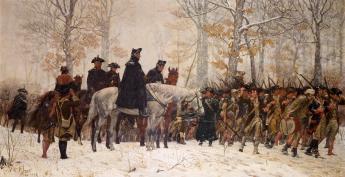
|
| Valley Forge |
Back in the gulch, however, is the spring where Washington's troops refreshed their canteens. Just beyond it is a great big rock, much mentioned in memoirs of the episode. Around 1950, the highway engineers decided to blast this rock out of the way of widening a road that badly needs widening. The Daughters of the American Revolution saved the day. Creating a giant fuss, the DAR succeeded in limiting the engineers to chiseling the bottom of the rock away. A gentleman in his eighties recently remarked he had driven past that rock thousands of times, and always wondered what it was there for. Now he knows.
La Fayette, We Are Here
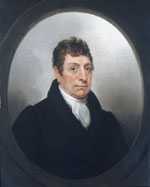 |
| Gilbert du Motier, marquis de La Fayette |
It will be recalled that La Fayette was 19 years old at Valley Forge, spoke no English, had no previous military experience. He nevertheless demanded, and got, a commission as Major General on the prudent condition that he have no troops under his command, at least for a while. Washington had been strongly reminded by various people that this young Frenchman was one of the richest men in France, a personal friend of the Queen, and thus critical to the project of enlisting French assistance in the war. Under the circumstances, it was shrewd to send him on the project of enlisting Indian allies among the Iroquois, since many tribes, particularly the Oneida, spoke French and held their former allies in the French and Indian War in great esteem. The chief of the Oneida Wolf clan (Honyere Tiwahenekarogwen) was visiting General Philip Schuyler in Albany at about the time LaFayette showed up on his mission to get some help for Valley Forge. General Horatio Gates was busy at the time rallying a colonist army to defend against the British under Burgoyne, coming down from Quebec, eventually to collide at the Battle of Saratoga.
Earlier in the war, Honyere's Oneida tribe had tangled with their fellow Iroquois under the leadership of Joseph Brandt (the Dartmouth graduate who was both biblical scholar and commander of several frontier massacres); the Oneida had many new scores to settle with the English-speaking Iroquois tribes. Honyere made the not unreasonable request that before his warriors went off to war, his new American allies would please build a fortification to protect his women and children from Brandt's Mohawks. LaFayette readily put up the money for this project, quickly becoming the Great French Father of the Oneidas. After some scouting and patrolling for Gates, Honyere and about fifty of his braves followed LaFayette to Valley Forge, where they soon made a nuisance of themselves to the Great White Father George Washington. Finally, word of the official French alliance with the colonists reached London, Howe was replaced by Clinton, and the British began to withdraw from their isolated position at Philadelphia.
It was thus that the jubilant rebels at Valley Forge learned that the fortunes of war had turned in their favor, and the French alliance was the source of it. With the British making preparation to abandon Philadelphia, it seemed a safe thing for Washington to give LaFayette command of two thousand troops, including the fifty Oneida Indians, and post them to Barren Hill (now LaFayette Hill), along Ridge Pike near Plymouth Meeting. Washington gave the strictest orders that they were to take no chances with anything, and particularly were to remain mobile, moving camp every day. This was not exactly what the richest man in France was anticipating, and wouldn't make a very saucy story to tell Marie Antoinette about. So, he promptly set about fortifying Barren Hill. Local Tory spies quickly spread this news to General Clinton, who promptly led eight thousand redcoats up the Ridge Pike to capture the bloody Frog. Clinton's plan was good; a detachment went around LaFayette in the woods and came back down Ridge Pike from the other direction, driving the Americans down the Pike into the open arms of the main body of British troops, coming up Ridge Pike. From this point onward, two entirely different stories have been told.
The more widely-held account has LaFayette climbing the steeple of the local church and noticing that there was an escape path, leading down the hill to the Schuylkill River at Matson's Ford. The Indian scouts were sent forward to hold off the British while the troops made their escape. Clinton sent a cavalry charge of Dragoons forward, yelling and waving their sabers, generally making a terrifying spectacle. The Indian scouts, as was their custom, were lying in the brush shoulder to shoulder, and at command by Honyere rose from the ground to let out a resounding chorus of war whoops. The Indians had never seen a cavalry charge, the Dragoons had never heard a war whoop, so both sides fled the battlefield without doing much damage. Meanwhile, LaFayette and his troops escaped to safety on the far side of the Schuylkill.
Other accounts of this episode relate that when Washington heard of it he remarked sourly that either they were pretty lucky, or else the enemy was pretty sluggish. In any event, a few soldiers were killed on both sides, the Americans crossing the River were described as "kegs bobbing on the pond", and it does seem the British army mostly just watched them do it. In the confusion, of course, everyone involved was fearful of being surrounded by unseen troops, and the British may well have worried the whole thing was a trap.
The saddest postscript to the Battle of Barren Hill is the fate of the Indians. After the war was over in 1783, the colonists busied themselves with taking over Indian land. Honyere pitifully petitioned the New York legislature for some consideration of his tribe's wartime service. They ignored him.
Meschianza
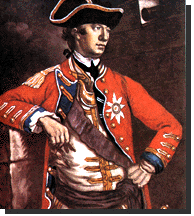
|
| General Howe |
The British under General Howe occupied Philadelphia for a little more than six months, withdrawing at the end of May 1778. Washington and his starving troops were shivering in the miserable encampment at Valley Forge that winter, and it is easy to imagine the British encircling, besieging or storming the encampment to put an end to the war then and there. Instead, Howe settled down in the enemy capital and had a merry time of it. Historians differ about the reasons for this puzzling behavior. On the one hand, Howe never did any campaigning in the winter if he could help it, somehow feeling that gentlemen soldiers had a right to revel, just as school children now feel they have a right to loaf in the summer. Perhaps there were practical military reasons to avoid winter campaigns, as well. However, it is also true that Howe had shown whig sympathies in the past, and very likely did feel that conciliation with the colonists was not only a possible but the best possible outcome of the dispute. If that was his idea, he was listening too much to the rich Tories in Philadelphia and not enough to the scowling artisan class, or to the solemn-faced Quakers. All winter long, the British soldiers revealed in theatricals and parties, apparently oblivious to the starvation nearby, or the appalled reactions of the sober Quakers to music, dancing, and ornamental dress. If Howe had any purpose to bedazzle the populace, he could not have put a better man in charge than his Lieutenant-General Major John Andre, whose thumb-in-your-eye attitude was defiantly underlined by his taking up Benjamin Franklin's own house as his pied a Terre.
Andre certainly cut a fine figure. It would be hard to say whether John Burgoyne or John Andre was the most dashing man in England, but it was surely one or the other. They both wrote plays and poetry of professional quality, designed costumes and scenery, and organized one extravaganza after another. They were both handsome in the eyes of ladies, and fearless soldiers in the eyes of men. Anything you can do, I can do better.
About the time Howe was replaced by General Henry Clinton and recalled to England, the position in Philadelphia began to look dangerous for the British. The French signed an alliance with the American Revolutionists earlier that spring, and the concern became a real one that the French fleet might blockade the mouth of Delaware and trap the British Army, stranded a hundred miles upriver from its own Navy. When Andre learned they were leaving, he saw they needed to have a celebration that would be remembered.

|
| Benedict Arnold |
Even today, the day-and-night revelry is indeed remembered. Andre wrote a detailed description for his local girlfriend Peggy Chew (the daughter of Pennsylvania's Chief Justice) that is really something to read. Made all the more pointed with our present hindsight that Peggy Chew was the best friend of the Peggy Shippen who married Benedict Arnold, the letter gives the celebration a made-up name, Meschianza. Sometimes spelled Mischianza, the derivation is loosely connected to the Italian word for Medley. It began with a regatta of costumed soldiers and local ladies on barges sailing slowly down the river accompanied by cannon fire, singing, and music. The main events of the week took place on the South Philadelphia plantation of Joseph Wharton, now called 5th and Wharton Streets. Horsemen of the British Army put on a Medieval tournament with jousting and whatever, dressed in white and pink satin, and hats of pink silk with white feathers on the brim. There were fireworks at night and banquets. Good wine, toasts, and laughter to witty remarks. The final high point was a fancy dress ball. Wow.
And then, the British moved across the river to New Jersey, and were gone.
REFERENCES
| Treacherous Beauty: Peggy Shippen, the Woman behind Benedict Arnold's Plot to Betray America: Mark Jacob:978-0762773886 | Amazon |
The Final Capture of Philadelphia (6)

|
| General Howe |
Philadelphia had only 25,000 inhabitants during the Revolutionary War. Now, nearly that many British soldiers of Sir William Howe poured into town, victorious. Victorious, except for being cut off from their supplies on the warships in the Chesapeake. Men war soon sailed up the Delaware River but found the narrow channel between Fort Mifflin and Fort Mercer in New Jersey blocked by strange contraptions called chevaux-de-frise. These instruments consisted of heavy timbers sunk to the bottom of the river, containing massive iron prongs that reached almost to the surface but pointing downriver. They were effective blocks to wooden vessels, almost impossible to dislodge. The general arrangement was: Fort Mercer on the top of the New Jersey cliff called Red Bank (now National Park), overlooking the blockaded channel. On the other side of the ship channel, Fort Mifflin on an island. A second channel between Fort Mifflin's island and the Pennsylvania shore was quite shallow, allowing special American gun barges and galleys to come down and attack the larger British vessels, then to escape pursuit by fleeing upstream. The Americans had two years to perfect this defense, and it was formidable. Only one or two large sailing vessels could maneuver near it downriver, and at least the Pennsylvania side was difficult to attack across the mud flats.
When Howe was earlier considering how to attack Philadelphia as he sailed Southward past the mouth of Delaware, he had decided it was hopeless for his fleet to attack this barrier if it was defended by an army, and the strategy evolved to defeat Washington, first. However, in the event, Washington's Army remained essentially intact after the conquest of the city, and from Valley Forge was able to interfere with supplies from the Chesapeake or lower Delaware Bay, but still send reinforcements to the river defense. The communication line on the Westside was essentially what is now the Blue Route, the third side of a triangle, from Conshohocken to Fort Mifflin, containing all of the British troops. The bend in Delaware made two sides of this triangle, and turbulence created by the river bend threw up mud islands which made the channel particularly narrow. These islands have since been filled in for the airport, the stadiums and the Naval yard, so the battleground is today, unfortunately, a little hard to make out, just as is also true of Bunker Hill, North Church, etc. in Boston Harbor.
Four or five hundred Americans were in each of the two forts, and eventually, most of them were wiped out, at least half of them by starvation and exposure as much as cannon and musket fire. They had British on both sides of them, heavy guns bombarding them, under attack for weeks. The British kept at it because to fail meant the loss, by starvation and snipers, of almost the entire British expeditionary force in America. A contingent of Hessians under von Donop was sent to Haddonfield and down the King's Highway to attack Fort Mercer from the rear. In a moment famous in Haddonfield, a champion runner named Jonas Cattell sneaked out of the town and ran to Fort Mercer to tell the troops to turn their guns around for an attack from the rear but lie concealed behind the guns, while meanwhile the Quakers in the little town entertained the Hessians in a very friendly way. There was more to it than that, with some heavy fighting in the open, but von Donop and most of his troops were casualties. The fort had been made smaller in the past, unexpectedly presenting the attackers with a second set of fortifications after they surmounted the outer ones. Later on, a second assault by a different contingent of Hessians did level the Fort. If not, there would have been a third or a fourth assault, because a river passage simply had to be forced to relieve starving Philadelphia. Before the repeated assaults were over, Fort Mifflin had also been bombarded into rubble. But what really carried the day for the British was the late realization that if small Americans boats could sneak down the channel on the Pennsylvania side of Mifflin; then small British boats could go the other way, as well. Although the river blockage was eventually broken, it took six weeks after the battle of Germantown, and meanwhile, the heroic defense did a great deal to rally the sympathies of what had been considered maybe a loyalist city, and partly loyalist Colony of New Jersey. Before the winter was over, Howe had to go back to London to explain himself, being replaced by General Clinton, who was much less clever and much more provocative as a conqueror. The first two years had British control by a minority of hothead aristocrats. For the remaining five years of the war, the sobered British concept was no longer liberation of colonial Tories, but the subjugation of fanatic Rebels. The realization gradually spread, through both England and America, that the war had been lost, since Independence was a more sustainable situation for everyone than continuing endless efforts at subjugation.
Grand Union
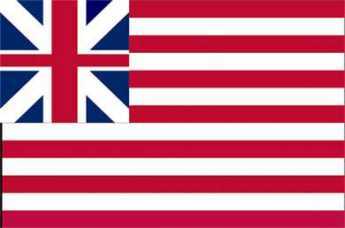
|
| Grand Union Flag |
THERE are a number of supermarkets in Philadelphia called Grand Union Stores, but the grocery conglomerate was founded in 1872. That Union was the Northern side in The American Civil War, and it is reported that life-sized replicas of Abraham Lincoln were once a common feature in the stores. Much earlier than that, the Grand Union was a term that meant the first American national flag, adopted in 1775, and created by a Philadelphia milliner, Margaret Manny. It was, however, quite similar to the flag of the British East India Company, and the Grand Union they were both talking about was the Union of England and Scotland of 1707. The jack of the Grand Union flag, soon to be replaced with a ring of thirteen stars, represented the crosses of England and Scotland, superimposed. When Northern Ireland joined the United Kingdom, the cross of Ireland was superimposed, to give the present form of the Union Jack. In 1775, the considerable colonial sentiment still hoped that hostilities would achieve a status for America along the lines of the other members of the United Kingdom.
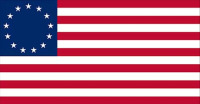
|
| "Betsy Ross" Flag |
Although the number of stripes in the national flag briefly increased to fifteen at the time of admission of Kentucky and Vermont, stripes soon reverted to thirteen to symbolize the original thirteen states. After that single exception, only the stars in the jack increased to match the number of current states.
The early use of the Grand Union Flag is in some dispute, but it may possibly have been used by George Washington in the various battles around Boston and Charlestown. It was most certainly flown by John Paul Jones on his ship the Alfred . Because of its resemblance to the flag of the nation we were fighting to overthrow, it is understandable that there would soon be a desire to change it. That is what happened in 1777, although just who first had the idea is still open to dispute and myth-making.
America has had three flag acts:
The Flag Act of June 14, 1777 was passed by the Second Continental Congress (under the Articles of Confederation, of course. June 14 is now called Flag Day.) "Resolved, That the flag of the United States be made of thirteen stripes, alternate red and white; that the union be thirteen stars, white in a blue field, representing a new Constellation."
The Flag Act of January 13, 1794 (1 Stat. 341) An Act making an alteration in the Flag of the United States. Be it enacted by the Senate and House of Representatives of the United States of America in Congress Assembled, That from and after the first day of May, Anno Domini, one thousand seven hundred and ninety-five, the flag of the United States, be fifteen stripes alternate red and white. That the Union be fifteen stars, white in a blue field.
The Flag Act of April 4, 1818 (3 Stat. 415) An Act to establish the flag of the United States. Be it enacted by the Senate and House of Representatives of the United States of America, in Congress Assembled, That from and after the fourth day of July next, the flag of the United States be thirteen horizontal stripes, alternate red and white: that the union be twenty stars, white in a blue field. And be it further enacted, That on the admission of every new state into the Union, one star be added to the union of the flag; and that such addition shall take effect of the fourth day of July then next succeeding such admission.
Philadelphia's Two Years Under Attack: A Chronology
June 1776 to June 1777 Although Virginia and New England were rebellious, the Quaker states regarded the British with sympathy until Benjamin Franklin was humiliated at Whitehall and returned to America as an ardent rebel. Either the English did not perceive or were unable to exploit this divisiveness, and made the mistake of dispatching an enormous fleet with 40,000 soldiers in a sign they meant to subjugate all of America. In a second mistake, this expeditionary force was headquartered on Staten Island, an ideal place to dominate the surrounding six colonies rather than the more fractious colonies of Massachusetts and Virginia. With this military force on its doorstep, the middle colonies finally joined the rest on July 2, 1776, and asked Thomas Jefferson to write a proclamation about it. The British soon advanced on land from Perth Amboy to Trenton, left a detachment of Hessians and went into winter quarters in New Brunswick. Washington attacked the Hessians, and when Cornwallis came storming to the rescue, circled around him and went after the unprotected supplies in New Brunswick. Cornwallis gave chase and lost the battle of Princeton. Washington went into winter quarters in Morristown, waiting for General Howe to react in the spring. Howe feigned embarkation and nearly trapped Washington, but soon went back to his lady friend in New York for the winter.
July 25, 1777 Admiral Lord Richard Howe and his brother General Sir Willliam Howe set sail from Staten Island for destination unknown. Washington watches helplessly from across the inlet at Perth Amboy, then falls back toward Philadelphia to protect his options.
July 31, 1777 British fleet sighted at the mouth of Delaware Bay. Washington moves to the Germantown encampment (now Fox and Queen Lane), prepared to defend the capital at Philadelphia.
August 10, 1777 When Howe, feeling he must destroy Washington before attacking the Delaware fortifications, does not enter the Delaware River, Washington orders the troops to go back up Old York Road to the Neshaminy encampment, midway between the head of the Chesapeake Bay and New York Harbor, because Howe's intentions are still unclear. Headquarters at Moland House in Bucks County.
August 23,1777 Howe's fleet is sighted off Patuxent, Maryland, then at Elkton, Maryland. Washington orders troops to defend along the Brandywine Creek. Howe lands Aug 25, in a driving rainstorm, possibly an Atlantic hurricane.
September 11, 1777 Washington is outflanked by Cornwallis' forced march around Dilworthtown, while Howe attacks the Brandywine in the largest military engagement of the Revolutionary War. Washington withdraws to Chester.
September 13, 1777 Washington stays only briefly at Chester, and returns his troops to the Germantown encampment they used a month earlier. From there he destroys all bridges and boats on the Schuylkill, then redeploys around Norristown, the first ford available to the British.
September 16, 1777, Both sides maneuver over a large area in Chester County for a second stage of the Battle of Brandywine, but a second torrential rainstorm ruins everyone's gunpowder ("The Battle of the Clouds") and fighting ceases. A contingent of 1500 Americans under General Wayne is surprised and butchered at night by a bayonet attack ("The Paoli Massacre"), and Howe crosses the Schuylkill on September 23 while Washington is forced to watch helplessly from the Whitemarsh area.
September 26, 1777. Howe marches triumphantly into Philadelphia but immediately splits his army into three groups, one directed at Fort Mifflin, one sent to New Jersey to forage, and the third but main body of troops deployed in Germantown. Washington sees an opportunity and organizes an attack on the Germantown contingent.
October 4, 1777. Battle of Germantown. The British successfully defend their position around the massive stone Cliveden (Chew) Mansion, and Washington is forced to fall back to Whitemarsh.
October 19 - November 16, 1777. Siege of Fort Mifflin, which eventually falls to the British, but not before their stunning defeat at Ft. Mercer on the New Jersey side of the river. The British fleet can now bring supplies up the river to a British army which was running low of them.
December, 1777 - June, 1778. The British enjoy winter quarters in Philadelphia, while Washington's troops suffer at Valley Forge.
June, 1778. The British defeats at Trenton and Saratoga persuaded the French to ally with the Revolutionaries. A hundred miles from blue water, concern about a French fleet prompts the British to withdraw from Philadelphia, crossing Delaware and marching up King's Highway in New Jersey to rejoin the British fleet at Perth Amboy/New Brunswick.
July 3, 1778. The Iroquois, urged on by the British, massacre 600 settlers in the Wyoming Valley, around present-day Wilkes Barre. General Sullivan is dispatched to annihilate the Iroquois. Hostilities in the war now shift to the Southern part of the country for the next six years.
The King's Road
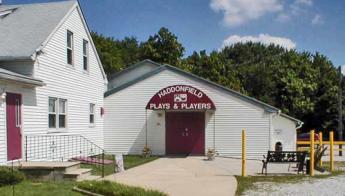
|
| Plays and Players of Haddonfield |
Harry Kaufman may not have started the Plays and Players of Haddonfield, but he certainly sparked it to a near-professional level in a town of 7000 people. The orchestra and the ballet company are particularly outstanding at the moment, the soloists on the stage quite good, although they never made the grand European tour which is thought to be the prerequisite for getting into the big time. Harry was the life of any party, and particularly good at composing little ditties, never quite getting around to stringing them together into a musical comedy until the 250th anniversary of the town. Even then, it is recalled he was shy and reluctant and had to be pushed a little. Since The King's Road appeared shortly after Oklahoma! transformed, even revolutionized, American musical comedy, it was not only the model but the stimulus for a similar comedy celebrating the beginnings of our little state. The plot was a simple one of a conflicted love affair. The striking innovation of Oklahoma! was to crowd most of the show's songs into the first act, repeating snatches of their themes as sort of Wagnerian background commentary throughout the remainder of the play. The other innovation of what was originally called Green Grow the Lilacs was the addition of Agnes DeMille's ballet company to emphasize the real historical theme with light-hearted music. Since I was one of the original reviewers for Oklahoma! in its New Haven tryouts, I can remember the revolutionary impact of that play, very well.
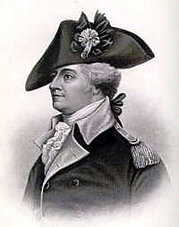
|
| Anthony Wayne |
Harry had to go to the Historical Society for authentic details of the conflict between the attraction for Revolutionary aspirations for Liberty, and loyalty to the earlier sufferings of Quakers for their pacifist leanings. Some Quakers deserted their faith to join the Revolution, and other Quakers tried to convert the Hessian soldiers. And still, others were loyal to the King of England. The Revolution was almost won at this moment, as the British occupants of Philadelphia had abandoned their supplies to attack, and had to get to the British fleet, bottled up in the lower Delaware River by fortifications at Fort Mifflin and Fort Mercer on the Jersey side of the river. The Hessians had been sent to attack Fort Mercer from the rear, passing through Haddonfield and stopping one night before going on to what we now call National Park. While the Hessian officers were being entertained by John Gill with discussions of the futility of war, Jonas Cattell slipped out of town and ran to alert Fort Mercer of its danger. The guns of the Fort were turned around, and the defenders pretended not to notice the approach of the Hessians until they were ambushed and largely destroyed. If Fort Mifflin on the Pennsylvania side of the Delaware River could have held out, the starving British might have had to surrender, but that didn't happen. In any event, the New Jersey Militia did its part, and little Quaker Haddonfield helped them in a sort of characteristic Quaker way. With a ratta-tat-tat and a fiddly dee, the rag-tag swallow-tail Jersey Militia got all the credit.
The play does not emphasize that the State of New Jersey was founded at the Indian King Tavern during these commotions, or that General Washington starving at Valley Forge sent Mad Anthony Wayne to circle up and around Trenton to drive a herd of cattle back from Salem County, two hundred miles back to Valley Forge. The British sent Captain Simcoe down to Salem County to massacre the Quaker farmers who provided the cattle. These later developments are only mentioned in its anthem to "Generals Wayne, LaFayette, and Pulaski", and every good resident of Southern New Jersey is supposed to know what that is all about.
The Quaker historian Rufus Jones established the enduring tradition that this split is what ultimately reduced the Quakers from the dominant religious group to a small religious sect in the three states once owned by William Penn, Delaware, Pennsylvania, and New Jersey. Related to such turmoil was the claim that more battles of the Revolution were fought in New Jersey than in any other state; if you include the large privateer navy going to see from the Jersey Pine Barrens, that is probably true. And every twenty-five years or so, we have to put on a revival of "The King's Road", and just show 'em.
Christmas, 1776, Behind the Scenes at Trenton
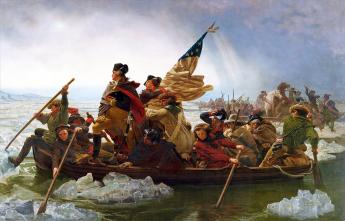
|
| Washington Crossing Delaware |
Cornwallis and the British regulars came thundering down the narrow waist of New Jersey from New Brunswick to Trenton, just before Christmas, 1776. Washington's troops retreated before them, fleeing to the Pennsylvania side of the Delaware River. The British then fortified the Hessians in Trenton and went back into their own winter quarters nearer New York. Plenty of time seemed available to finish off Washington in the Spring, and then leisurely conquer the enemy's capital in Philadelphia. The Continental Congress thought so, too, and moved its capital to Baltimore. Only three members of the Congress, Robert Morris, George Clymer, and George Walton (of Georgia), remained in Philadelphia to run the government; Morris was essentially in charge, in the role of financier whatever that meant. With Congress seeking refuge, Morris was for practical purposes, acting President of the United States. Washington swept up all of the boats on Delaware, set up camp on the Pennsylvania side, and begged Morris to get him some money to reward re-enlistments by January 1. Others saw the end of the year as Christmas time; Washington saw it as the end of the year when enlistments expired. He quite plainly stated that it was all over for the Continental Army unless he could get some hard currency, silver preferred, to show the troops that the rebellion could survive another year. About ten dollars per soldier would probably do it, but then there was also a need for hard money to buy food and supplies for the starving troops.
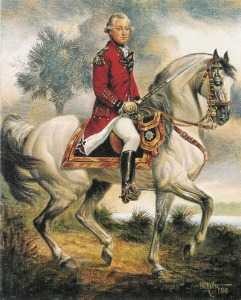
|
| General Charles Cornwallis |
Just how Morris managed to find the money is unclear, or how much of it was his own. But he did manage, with the lucky arrival of a gunpowder smuggling ship from France, and eighteen cannon somehow supplied by General Knox. The Colonials rallied to re-cross Delaware, surprise the Hessians, outmaneuver Cornwallis as he once more thundered back down the New Jersey waist, now intent to wreak vengeance. The military essence of it all reached a climactic moment when Washington used fake bonfires to trick the British while he sneaked around them. Captain Sam Morris and Philadelphia's First City Troop managed the bonfire deception. When cannon fire in Princeton announced the trick, the British raced back to their ships at Staten Island to protect their supplies before Washington who now had a head start, could get to the ships, leaving the British to starve in the woods. Both sides were exhausted by the chase, and although he had won this race, Washington had to retreat to winter quarters in Morristown, New Jersey (named after a former New Jersey Governor.) Meanwhile, with Congress taking refuge in Baltimore, Philadelphia was nearly deserted except for some Quakers who felt they had no quarrel with the British. And Robert Morris, who continued to run his smuggling operation with Beaumarchais the famous playwright on the French end of it. Tradition has it that some Quaker gardens were dug up to find enough silver to reward reenlistments, and if so it is unclear how much was freely contributed and how much was just plain stolen; indeed, how much of it might have been Morris' own money. By the next fall, Washington was able to fight the largest battle of the war at the Brandywine Creek, so Morris must have been very active smuggling guns and gunpowder to resupply the Colonials during that intervening winter and spring.
During periods of the lull in infantry warfare, other warfare including privateering at sea, blockades, and the diplomatic intrigue in Paris, were unmerciful. If Washington's army had been wiped out, the Revolution would have ended. But other misadventures might have ended it as well. The colonists were demoralized, and their dismay was summarized by a letter from Morris to Silas Deane, a line of which was the bitter observation that "Sorry I am to say it, many of those who were foremost in noise, shrink coward-like from the danger.".
A few days before that fateful Christmas, Ben Franklin had arrived in Paris to take over our diplomatic mission with the French. When the news of Washington's victory reached him, the new American arrival was being acclaimed as the world-famous scientist and witty author and was thus in a position to make the most of it with the French court. He may be forgiven for exaggerating Washington's exploits a little. The Trenton victory was rough and ragged, but it would serve. Washington, Franklin, and Morris. The three Americans who mainly won the Revolutionary War for us now took the stage, front and center.
Battle of Monmouth

|
| Battle of Monmouth |
A moving army tends to get strung out on roads through unfamiliar territory, and when boarding ships leaves a steadily diminishing rear guard to protect the fleet. Thus, General Clinton's retreating British army presented an opportunity for Washington to harass them, take advantage of unexpected delays, and to be wherever they were going. So Washington ordered the Continental Army out of Valley Forge, to pursue the retreating British as they moved over the Delaware River to Camden, joining the King's Highway at Haddonfield, heading for Sandy Hook and the waiting ships of the British Navy. As both armies approached Monmouth Court House, Washington caught up with Clinton and ordered his deputy, General Charles Lee, to attack with an advance force that would hold the British in place until Washington's main force could catch up. Both armies had about 13,000 soldiers in strength, but only 9,000 of Clinton's men were engaged because of their strung-out deployment.
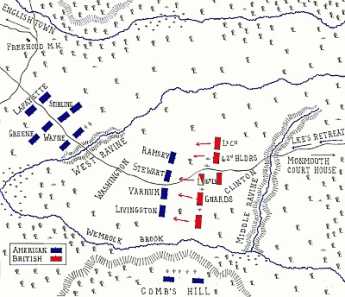
|
| Battle of Monmouth Map |
Washington's battle plan was therefore vindicated, and the next showed his characteristic ability to use terrain to his advantage. The New Jersey countryside breaks up into hills as it approaches New York harbor, and its valleys between hills tend to contain creeks at the bottom. Therefore, the retreating British were forced into narrowing valleys which exposed them to flanking maneuvers but reduced the room for Washington to be outflanked. Lee failed to take such effective advantage of the terrain and made only half-hearted attacks on the British. When Washington and the main body of troops caught up with him, Lee was promptly relieved of command and later court-marshaled. In his place, Washington sent Nathaniel Greene around the enemy's southern flank, setting up four artillery pieces on a high hill, protected from British attack by a flooded creek. He was thus able to "enfilade" the British line, aiming cannonballs at the near end where they would bounce up the British line if they fell short, or land in the far end of the British line when they overshot. The cannons now look fairly small and puny, but with a well-trained crew of a dozen artillerymen, each one could get off five to ten shots a minute. With four pieces of artillery, they could drop twenty to forty shots a minute onto the confused and compressed formation of enemy troops. The battle went on all day, the longest battle of the Revolution.
Under the cover of darkness, Clinton withdrew his troops toward Sandy Hook, leaving six hundred casualties on the ground, two-thirds of the British. The British could claim they achieved their objective of reaching the ships, but with greater casualties, and forced to withdraw in the face of discovering a much better-disciplined American army than they had ever faced. They acquired a new respect for Washington, who demonstrated boldness and outstanding tactics, with professionalism quite equal to their own.
REFERENCES
| New Jersey in the American Revolution: Barbara J. Mitnick: ISBN-13: 978-0813540955 | Amazon |
Peace, Disdained
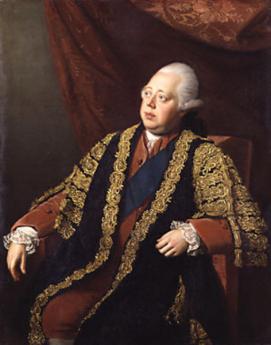
|
| Lord North |
The most decisive victory of the Revolutionary War was the Battle of Saratoga, where the British lost an entire army at a critical moment. Before Saratoga, Colonial hopes were at a low point. The British then occupied Philadelphia and Washington was shivering in Valley Forge. It's probably of relevance that the Continental Congress had fled to Baltimore, then York, and Robert Morris was trying to manage the mechanics of government from Manheim, near Lancaster. Within occupied Philadelphia, the dominant Quaker population had largely abandoned involvement in politics, and although there were a handful of wealthy merchant leaders living on 3rd Street, it's questionable how much the populace listened to them. Mayor Samuel Powel, for example, was so wealthy he didn't much care who won the war and spent much of his time entertaining notable foreign visitors.
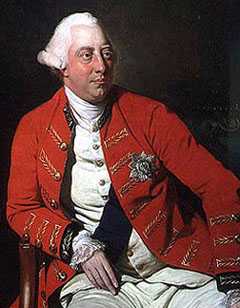
|
| King George III |
Defeats have consequences, and the loss at Saratoga resulted in the British replacing General Howe with General Henry Clinton. A French fleet poked at New York harbor before giving the idea up and settled on attacking Newport, Rhode Island. Although this initiative ended in a draw because of what was probably an Atlantic hurricane, it was not at all a far-fetched idea that the French fleet might position itself anywhere on the Atlantic coast. Blocking the mouth of Delaware Bay would strand Howe's army a hundred miles upriver, with Washington's newly trained troops on the far side, cutting off supplies from the countryside. It would be a precarious position, so Lord North not only replaced General Howe but ordered the abandonment of Philadelphia. General Clinton thus had an orderly retreat from Philadelphia as his first priority and was occupied preparing for it.
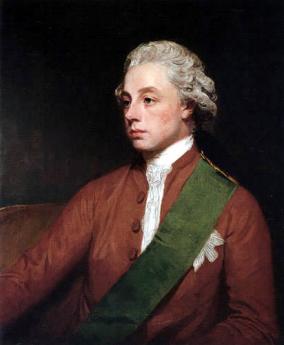
|
| Earl of Carlisle |
This was not merely a low point for the British in America. They were now also fighting world-wide wars without allies, against France, Spain, Holland, and lesser principalities. These enemies of England were making trouble, busily planning more of it. The conquest of India was in question, the West Indies Sugar islands were widely regarded as more economically important than the thirteen colonies to their north. France was organizing an invasion of the British Isles by a Second Armada in 1779, and there was to be serious rioting in the streets of London in 1780 when the Protestant Association under George Gordon reacted badly to Parliament relaxing the Catholic restraints. Behind the Gordon riots was another ominous fact; British manpower was overstretched and could use more sources of troops. Even though Lord North bore such a striking physical resemblance to King George III that it was widely rumored they were secretly brothers, the North Prime Ministry was in serious trouble. Lord North called in the thirty-year-old Earl of Carlisle and dispatched him to America to negotiate peace. His terms were essentially the ones considered for Ireland: the colonies could have a parliament of their own, in return for maintaining trade relationships with England. It was not an unreasonable time for the British to stop the war, and the terms they offered seemed to satisfy every demand the irate colonists had asked for. Behind the slogan "No taxation without representation", lay more than a century of amicable relations with the colonies, restless at most that they had not been fully treated like Englishmen. Lord North had every reason to believe these terms would be acceptable, and many reasons of his own to be done with the Colonial quarrel. The counterfactual is that if the offer had been accepted, the Revolutionary War would have ended six years earlier than it did, without much difference in the final terms, and the War of 1812 would never have happened; history would surely have applauded North's statesmanship. Unfortunately, there was not much preparation for this peace overture, and there was really no obvious power structure in America at that moment to deal with it. It seems possible the Earl of Carlisle encountered some random handful of Americans who wanted independence more than they wanted peace or British officers who wanted revenge. But it also appears likely this thirty-year-old guardian of a famous poet simply was not equal to the momentous challenge he faced. The available history is too scanty to judge.
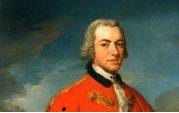
|
| General Clinton |
All we now know for certain is that the Earl of Carlisle showed up in Philadelphia with an entourage, and the town mansion of Samuel Powel (not to be confused with his country place called Powelton) was commandeered, pushing the Powel family into the servants quarters. Carlisle hung around for two weeks while General Clinton was packing up, essentially got nowhere with his mission, and went back home. There's surely some astounding story behind these events; somebody on the Rebel side must have been approached, and the terms may not have suited him. Since the same offer was made four years later and more emphatically rejected, there surely were people around 3rd Street who found it easy to let the matter die. If anyone is young and energetic enough to dig into the papers of the time, this episode would at least be an excellent subject for a thesis.
Museum of the American Revolution
The Right Angle Club of Philadelphia was recently pleased to be visited by Michael C. Quinn, the President, and CEO of the forthcoming Museum of the American Revolution, which will be built at Third and Chestnut Streets, on the site of the former Visitors Center. Mr. Quinn comes to us from the Mt. Vernon and James Madison Museums in Virginia and expects to spend another three years getting the new Museum built and established. It's also expected to cost about $150 million, so look for something really special. The great majority of the required money is expected to come from Philadelphia and surrounding territory, led by a challenge grant from Gerry Lendfest of $40 million.
The collection of Valley Forge and related Revolutionary artifacts was begun by Herbert Burk, an Episcopal rector in Norristown, Pennsylvania, and the son of another Episcopal rector of Clarksboro, New Jersey, and who graduated from the University of Pennsylvania toward the end of the Nineteenth century. The Valley Forge area was pretty well deserted at that time, and the local bishop expressed doubt that it could support both an Episcopal and a Baptist church, particularly since an earlier rector named Guthrie had attempted it and finally disappeared. Reverend Burk, however, was fired with the vision of Washington kneeling in the snow, and highly scornful of doubters who insisted on seeing his footprints in the snow before they would accept it. These were the days just after the German historian Leopold von Ranke had started a movement of great enthusiasm among historians for documents to prove almost anything calling itself history, so there was more than the usual amount of harumphing among academics about authenticity, which Burk dismissed with scorn. Since his second wife was a Stroud, there may have been social issues as well. About all, we really know of George Washington's religious beliefs was that he regularly went to Christ Church and sat in Martha Washington's pew; but he resolutely refused to take Communion. It sounds to some of us as though he was more of a politician than a theologian. But the Museum now has picked up successor enthusiasts, determined to make the Museum a success; so let's let that religion matter drop.
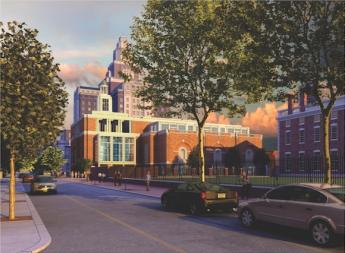
|
| Museum of the American Revolution |
The old visitors center was given a bell by Queen Elizabeth II, who brought it over on the royal yacht and gave a memorable speech at its installation. The deed to the property does not include the bell, and its future is presently uncertain. However, the building will be torn down and replaced by a much larger structure, intended to house many rooms and a tour lasting hours, to show off Washington's military tent and similar artifacts of the low point of the Revolution, when it rested with the personal character of a few founding fathers, to preserve the drive and idealism of the freezing, starving troops. It's a tall challenge for Mike Quinn to carry it off with the right mixture of showmanship and concern for accuracy. After all, no good story is improved by exaggeration.
Fort Mifflin
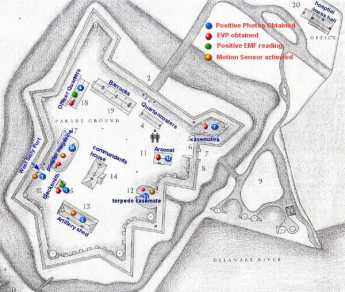
|
| Map of Fort Mifflin |
The Administrator of Fort Mifflin, Beth Beatty, recently addressed the Franklin Inn Club about it. The famous fort, whose defeat marked the end of Philadelphia's resistance to the British invasion, is now owned by the City of Philadelphia, hidden behind the approaches to the International Airport. It shows a lot of signs of two centuries of wear and tear because for a number of decades after the Revolution it was still in use as a fortification. Built on a swamp, one most notable feature is it can be very wet, much of the time, and is subject to repeated floods that most of us on the higher ground pass off as rainstorms. But it's still there, and it must be pretty sturdy.
British frigates were patrolling upper Delaware well before July 4, 1776, and Benjamin Franklin was a member of the Committee on Safety. As such, he is given credit for inventing the chevaux de frise, which filled in the gaps in the mudflats at the turn of the river. These inventions are best imagined as the "do not reverse" treadles of modern parking lots, buried in the riverbed and quite effectively preventing the sailing ships of the day from passing upstream. Fort Mercer was placed on a small bluff protecting the New Jersey side, and Fort Mifflin held the Pennsylvania side of the river, but more notably wallowing in the mud.
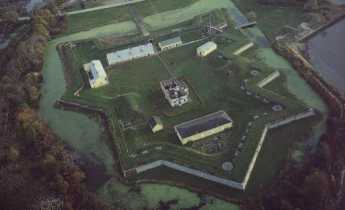
|
| Fort Mifflin |
The fort has been named after Thomas Mifflin, Pennsylvania's first governor. Unfortunately, Mifflin was the main conspirator in the so-called Conway Cabal which later tried to dislodge George Washington from the role of Commander while he was still at Valley Forge. Mifflin was a total drunkard, and behaved disgracefully as Governor, signing over huge plots of state land to himself, along with his subverted controller, John Nicholson. Much of the bankruptcy of Robert Morris can be traced to the manipulations of these two colonials, although that famous bankruptcy played such a central role in the political arguments of the early 19th Century it will probably always be difficult to be sure where to place blame. Since Morris was one of the three men (along with Franklin and Washington) without whom the Revolution could not have been won, his responsibility in the post-war land speculations tends to benefit from shifting the burden of proof toward the other two participants, perhaps even accurately.

|
| Fort Mifflin Powder Room |
An interesting part of the Fort Mifflin site is to discover that the powder magazines were buried underneath the foundation footings of the main brick defensive wall. The gunpowder effectively had a roof of the entire main wall. That made it particularly difficult for cannon fire to ignite the gunpowder stores and probably played a large role in the ability of the Fort to hold out against the British for considerably longer than anyone expected. Since the fort had been built while the British were still in control before the Revolution, the attackers were eventually able to consult with the architect, who advised them to bombard the Pennsylvania side of it, which was mainly made of mud rather than solid brick. It should be remembered that the British had disembarked at the Head of Elk in Maryland when they launched the original attack behind Philadelphia. They thus carried minimal supplies and food on what was mainly a cavalry charge, taking a great risk they would not be able to rejoin the British fleet in time. The fleet circled back down the Chesapeake Bay and returned up to the Eastern Maryland coast to Delaware Bay. When they found their way blocked for days and weeks at Fort Mifflin, Lord Howe's troops inside Philadelphia were at great risk of starving, and/or running out of ammunition. Washington seems to have recognized the advantages he had and was willing to sacrifice the fort for a prolonged defense. The British Navy on the downside of the Fort, equally aware of the need to break through quickly, pummelled the Fort with thousands of cannon shot and shell. The Americans inside the fort adopted the ingenious strategy of building the walls up at night, ready at dawn to withstand another day of bombardment. It has been reported that most of Ft. Mifflin's defenders were teen-aged boys, perhaps mostly overestimating the odds of their own survival.
It was a gallant try, but eventually the overwhelming force of the British Navy broke through. The American capital had been taken.
| Posted by: amber | Oct 6, 2011 3:37 PM |
| Posted by: Dr Michael Weir | Apr 27, 2011 2:29 PM |
| Posted by: Hi | May 15, 2010 11:35 AM |
| Posted by: Jon Rosenthal | Feb 18, 2010 9:51 PM |
The second painting, under the sub-heading, "Easy Ride:.." is "The Death of Major Pearson", an event which took place in 1781 in the opening moments of the Battle of Jersey (in the CHANNEL ISLANDS - i.e. the place after which NJ is named), during an unsuccessful attempt by France to invade the island.
| Posted by: Amused Jerseyman | Apr 11, 2009 11:19 PM |
| Posted by: g4 | Oct 17, 2007 10:17 AM |
28 Blogs
What Happened in Philadelphia on July 4, 1776?
 There were about 30,000 residents, just a small town, but it was the second largest city in the English-speaking world. Aside from wagons, there were thirty wheeled vehicles. But this is the town where decisions were made.
There were about 30,000 residents, just a small town, but it was the second largest city in the English-speaking world. Aside from wagons, there were thirty wheeled vehicles. But this is the town where decisions were made.
British Headquarters: Perth Amboy, New Jersey, in its 1776 Heyday (B 608)
 Now dispirited and forgotten, Perth Amboy was once the glamorous capital of New Jersey. Its harbor and neighboring Staten Island were headquarters for the Admiral Howe's British fleet during most of the Revolution.
Now dispirited and forgotten, Perth Amboy was once the glamorous capital of New Jersey. Its harbor and neighboring Staten Island were headquarters for the Admiral Howe's British fleet during most of the Revolution.
Perth Amboy Revisited
 Perth Amboy was once the capital of New Jersey and the entry point of General Howe's invasion of the rebellious colonies. Except for one old building, you might never guess.
Perth Amboy was once the capital of New Jersey and the entry point of General Howe's invasion of the rebellious colonies. Except for one old building, you might never guess.
Philadelphia Vaguely Hears About Bunker Hill
 Massachusetts and Pennsylvania were far apart in 1775, both in distance and culturally. The Boston revolt was an underground conspiracy, aiming for New England home rule within the British Empire, but after two years and thousands of casualties, there was no turning back, and no hope of victory without the other English colonies. It was the British who jumped the gun and faced all thirteen colonies with a choice of subjugation or fighting for Independence.
Massachusetts and Pennsylvania were far apart in 1775, both in distance and culturally. The Boston revolt was an underground conspiracy, aiming for New England home rule within the British Empire, but after two years and thousands of casualties, there was no turning back, and no hope of victory without the other English colonies. It was the British who jumped the gun and faced all thirteen colonies with a choice of subjugation or fighting for Independence.
Easy Ride: Perth Amboy to Trenton
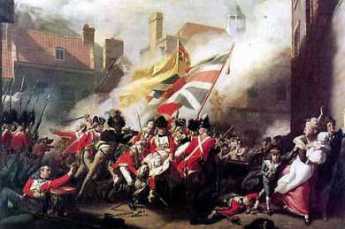 The British Army romped down the narrow waist of New Jersey, from New Brunswick to Trenton. But it's not safe to go too fast, too far into enemy territory.
The British Army romped down the narrow waist of New Jersey, from New Brunswick to Trenton. But it's not safe to go too fast, too far into enemy territory.
Disorderly Retreat: From Trenton Back to Perth Amboy
 At the Battle of Trenton, George Washington established his military reputation for all time.
At the Battle of Trenton, George Washington established his military reputation for all time.
Howe's Choice: To Philadelphia, or Saratoga?
 The Howe brothers may have been socialites, and they had formerly been members of the Parliamentary party favorable to peace in the colonies. But they were also seasoned, smart soldiers who played hard and played to win. Washington proved to be their match, but he did have to prove it.
The Howe brothers may have been socialites, and they had formerly been members of the Parliamentary party favorable to peace in the colonies. But they were also seasoned, smart soldiers who played hard and played to win. Washington proved to be their match, but he did have to prove it.
Why Did Admiral Howe Choose the Chesapeake?
 Navigation of the Delaware Bay was too tricky for Admiral Howe's fleet, even though there were good landing spots.
Navigation of the Delaware Bay was too tricky for Admiral Howe's fleet, even though there were good landing spots.
Encampment At East Falls
 To follow the story chronologically, however, we must first follow Washington to Moland House in Bucks County, after the first East Falls encampment.
To follow the story chronologically, however, we must first follow Washington to Moland House in Bucks County, after the first East Falls encampment.
Washington Lurks in Bucks County, Waiting for Howe to Make a Move
 Washington, LaFayette, and twenty-seven other famous heroes of the Revolution spent a week in this Bucks County farmhouse, waiting for the British to make a move. Washington had a bottle of Madeira every day for lunch, but Mrs. Moland made him sleep on the floor, and pay for cleaning up when they left.
Washington, LaFayette, and twenty-seven other famous heroes of the Revolution spent a week in this Bucks County farmhouse, waiting for the British to make a move. Washington had a bottle of Madeira every day for lunch, but Mrs. Moland made him sleep on the floor, and pay for cleaning up when they left.
Defeat and Disaster: Philadelphia Falls to the Enemy

Battle of the Clouds: September, Remember
 Benjamin Franklin, it should be noted, was the first to observe that Atlantic Coast "Nor'easters" actually begin in the South and work North, even though the wind seems to be blowing the other way.
Benjamin Franklin, it should be noted, was the first to observe that Atlantic Coast "Nor'easters" actually begin in the South and work North, even though the wind seems to be blowing the other way.
Fort Washington, PA
 Fort Washington PA was never much of a fort, and nothing of it remains to be seen. Rather, it was mostly a large campground north of Philadelphia between the Battle of Brandywine and the Battle of Germantown. An interesting visit, nonetheless. A side-visit to Hope Mansion would add some local color.
Fort Washington PA was never much of a fort, and nothing of it remains to be seen. Rather, it was mostly a large campground north of Philadelphia between the Battle of Brandywine and the Battle of Germantown. An interesting visit, nonetheless. A side-visit to Hope Mansion would add some local color.
The Battle of Germantown: Oct. 3, 1777

Espionage in the Revolution
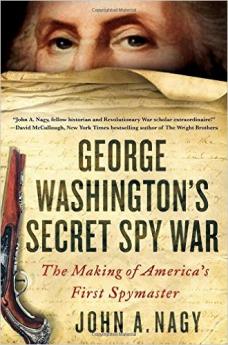 Almost everyone in the American Revolution could speak English, so it is not surprising to hear of many spies.
Almost everyone in the American Revolution could speak English, so it is not surprising to hear of many spies.
Peggy Shippen and Benedict Arnold: Fallen Idols
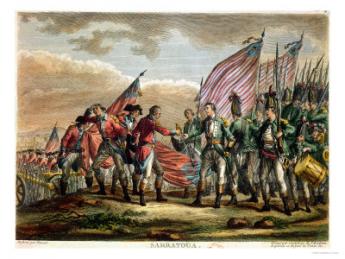 The hero of the Battle of Saratoga married the Queen of Philadelphia society, but then betrayed the country.
The hero of the Battle of Saratoga married the Queen of Philadelphia society, but then betrayed the country.
Rebel Hill
 Everybody knows Washington's troops retreated to Valley Forge, but not everybody realizes how he got there.
Everybody knows Washington's troops retreated to Valley Forge, but not everybody realizes how he got there.
La Fayette, We Are Here
 LaFayette's first experience in charge of troops very nearly ended in his capture.
LaFayette's first experience in charge of troops very nearly ended in his capture.
Meschianza

The Final Capture of Philadelphia (6)

Grand Union
 Thirteen stars and stripes became the National Flag in 1777, but a rather similar flag was the National flag from 1775-1777. It was also designed by a Philadelphia milliner, Margaret Manny.
Thirteen stars and stripes became the National Flag in 1777, but a rather similar flag was the National flag from 1775-1777. It was also designed by a Philadelphia milliner, Margaret Manny.
Philadelphia's Two Years Under Attack: A Chronology
the First year: The British marched from Perth Amboy, back to Perth Amboy.
the Second year: The British sailed from Perth Amboy, back to Perth Amboy.
The King's Road
 It's only been performed fifteen or twenty times, but Hayyr Kaufman's musical comedy captures the real spirit of Olde Haddonfield.
It's only been performed fifteen or twenty times, but Hayyr Kaufman's musical comedy captures the real spirit of Olde Haddonfield.
Christmas, 1776, Behind the Scenes at Trenton
 Christmas may have been a good time to surprise the Hessians at Trenton. But it was also a week before many enlistments of Washington's Continental army expired. Now or never..
Christmas may have been a good time to surprise the Hessians at Trenton. But it was also a week before many enlistments of Washington's Continental army expired. Now or never..
Battle of Monmouth
 The British Army evacuated Philadelphia in June 1778, retreated across the narrow waist of New Jersey for the safety of their Navy at Sandy Hook. Washington caught up with them at Monmouth and fought a very creditable battle.
The British Army evacuated Philadelphia in June 1778, retreated across the narrow waist of New Jersey for the safety of their Navy at Sandy Hook. Washington caught up with them at Monmouth and fought a very creditable battle.
Peace, Disdained
 After the Battle of Saratoga, Lord North offered the colonists what amounted to six extra years of peace. The offer got lost in the shuffle.
After the Battle of Saratoga, Lord North offered the colonists what amounted to six extra years of peace. The offer got lost in the shuffle.
Museum of the American Revolution
 The old Visitors Center at Third and Chestnut has been vacant for more than a decade. Its new occupant is going to be a Museum dedicated to the causes and sacrifices of the American Revolution.
The old Visitors Center at Third and Chestnut has been vacant for more than a decade. Its new occupant is going to be a Museum dedicated to the causes and sacrifices of the American Revolution.
Fort Mifflin
 Ordered by George Washington to fight on "to the utmost extremity", the Revolutionary War defenders of Fort Mifflin came close to defeating the British Navy.
Ordered by George Washington to fight on "to the utmost extremity", the Revolutionary War defenders of Fort Mifflin came close to defeating the British Navy.